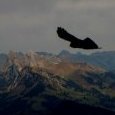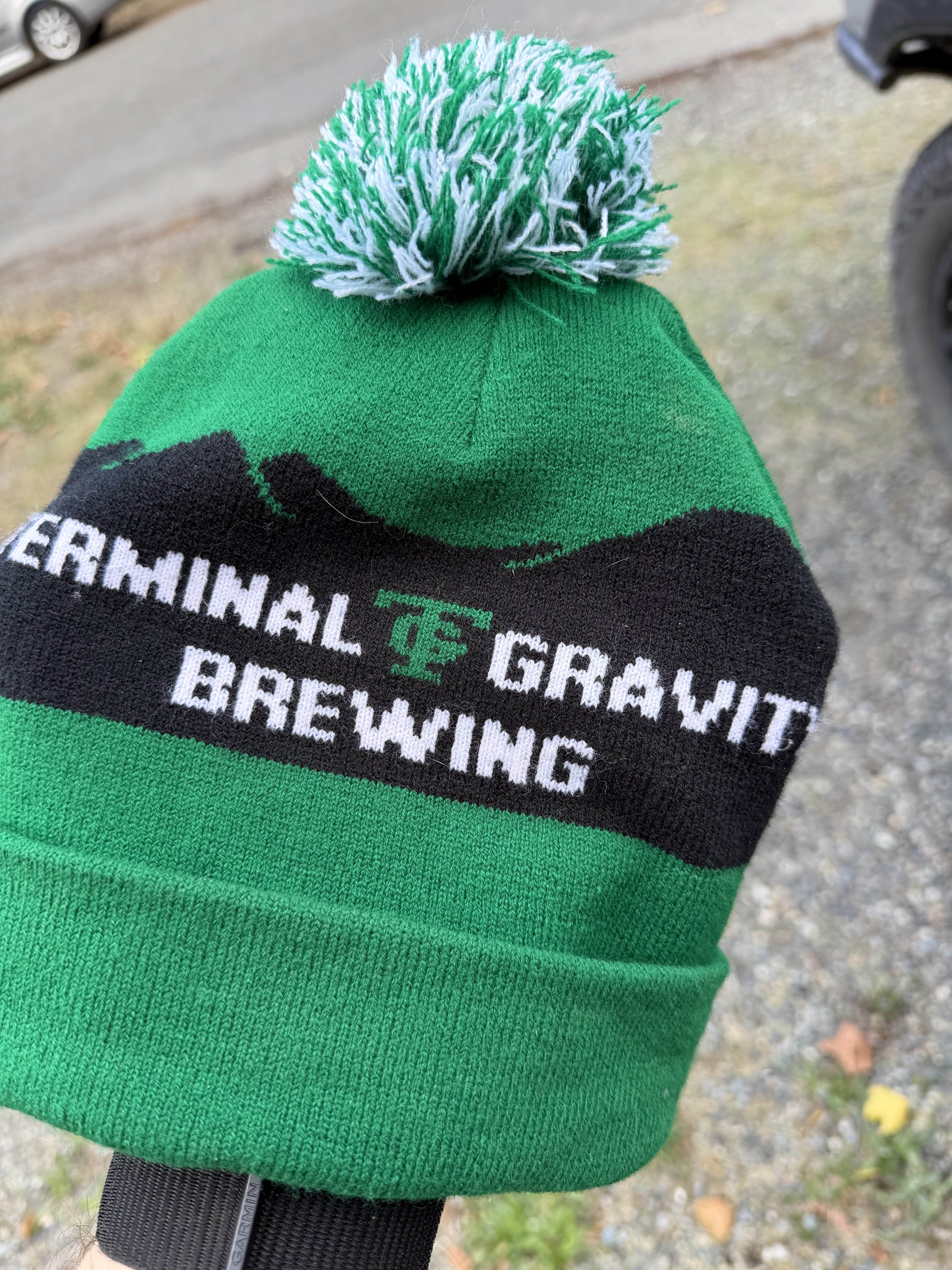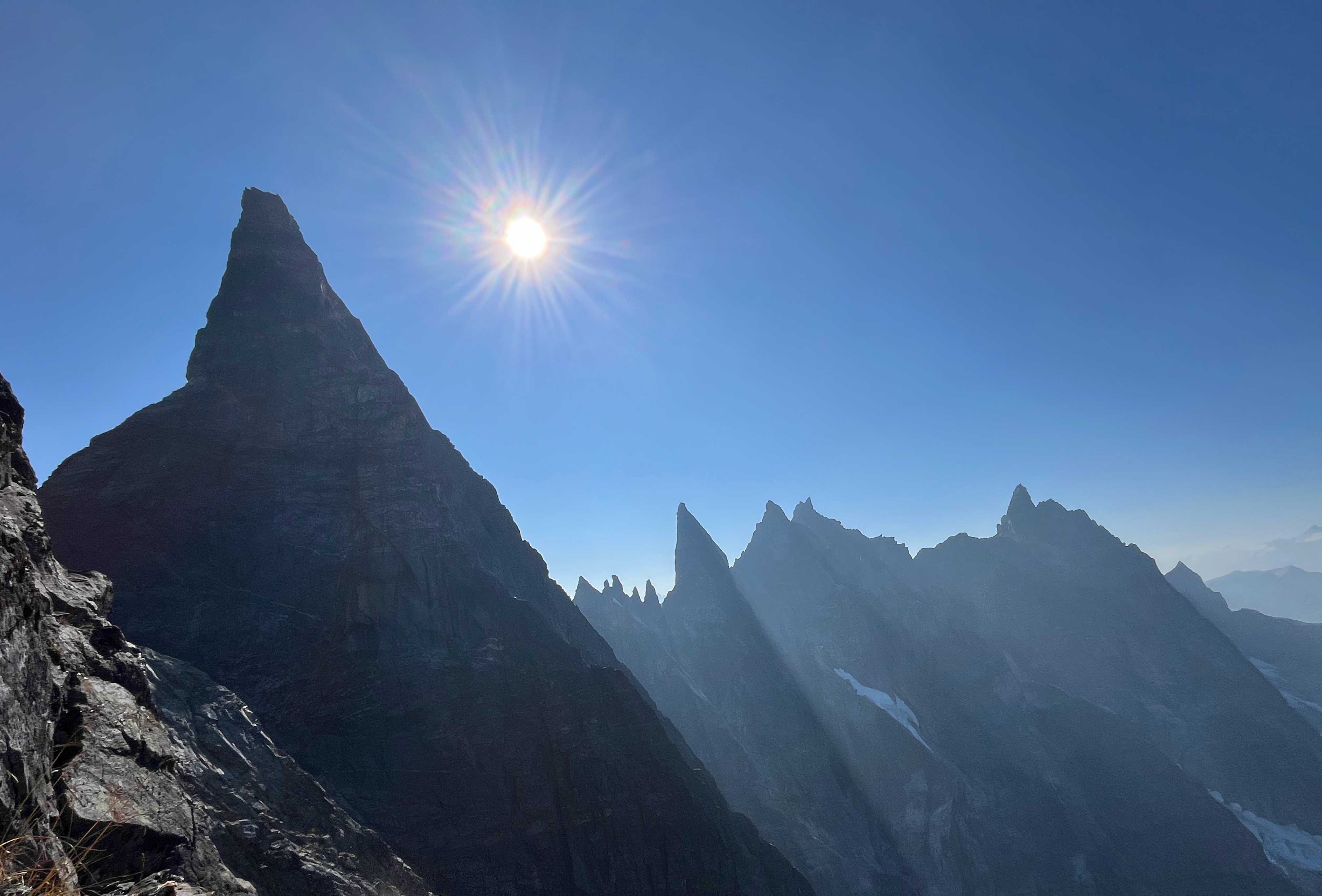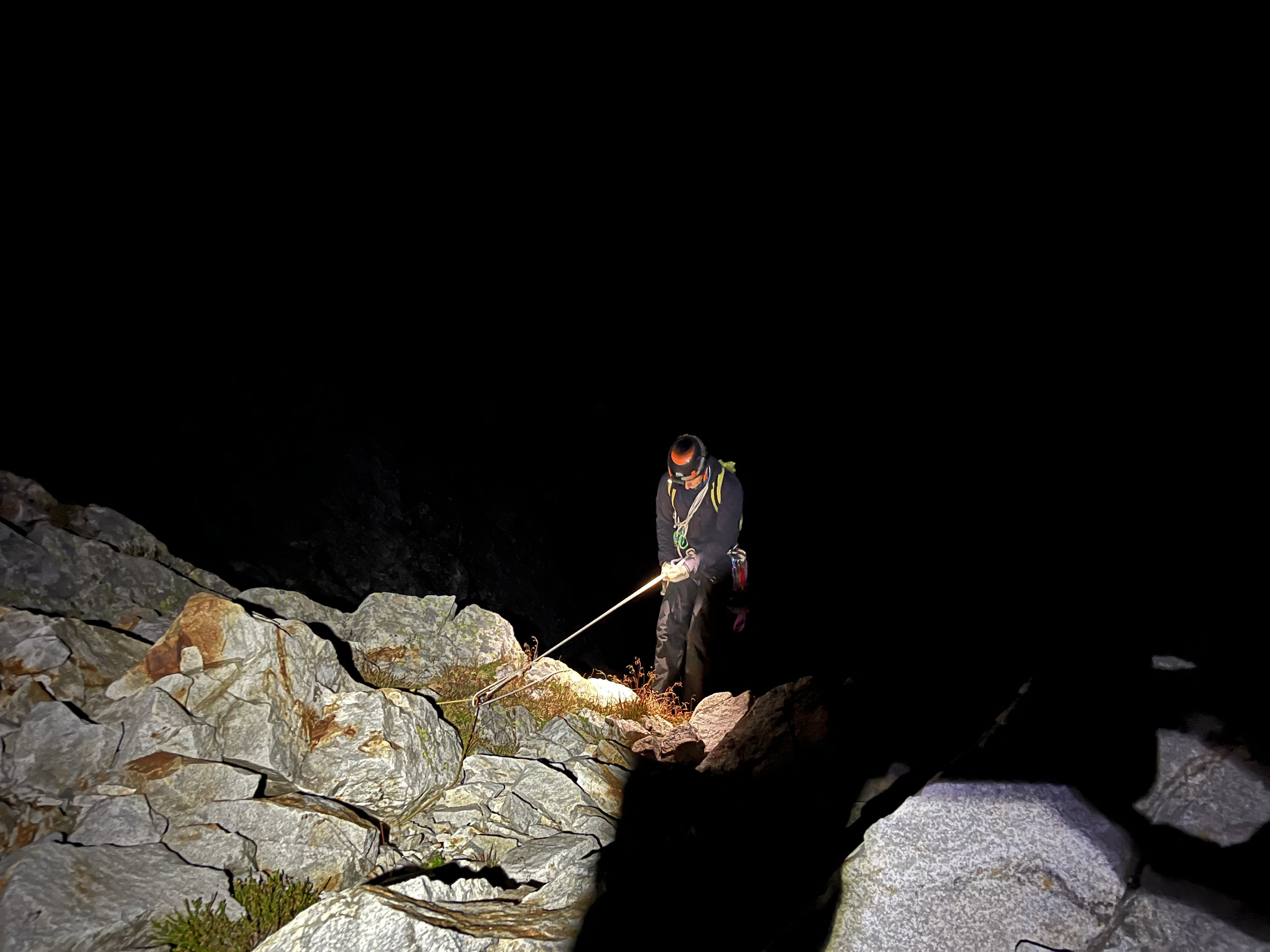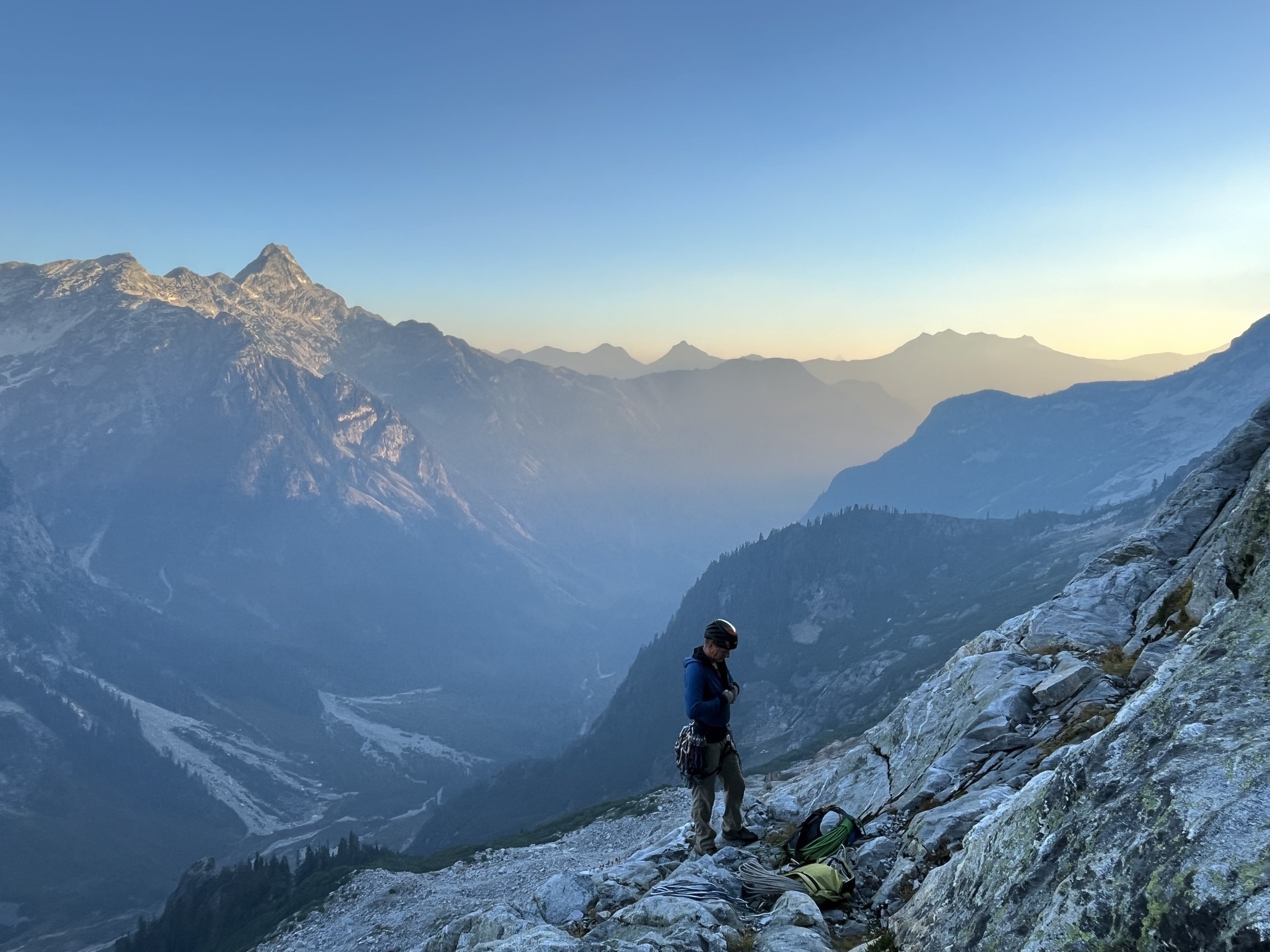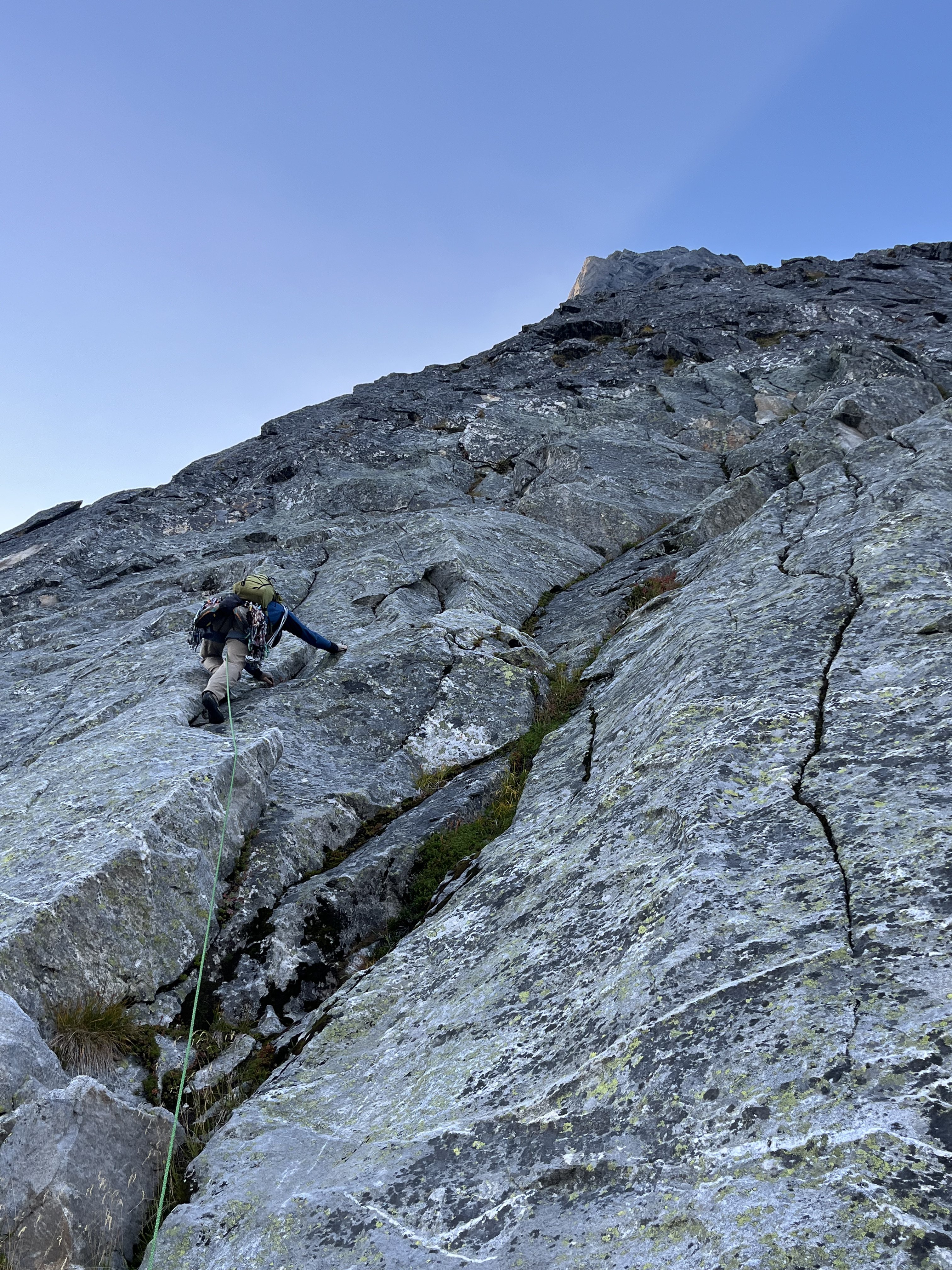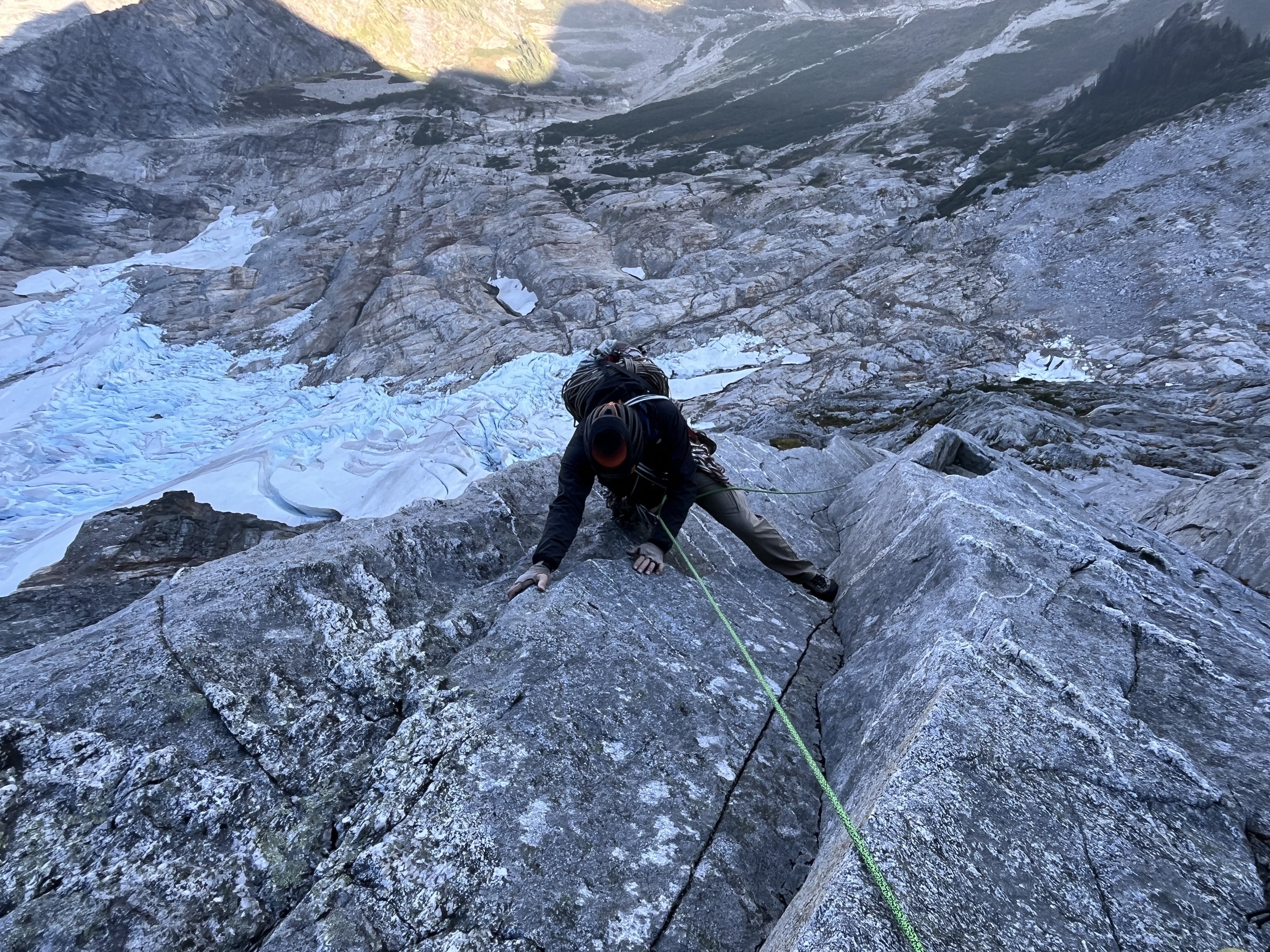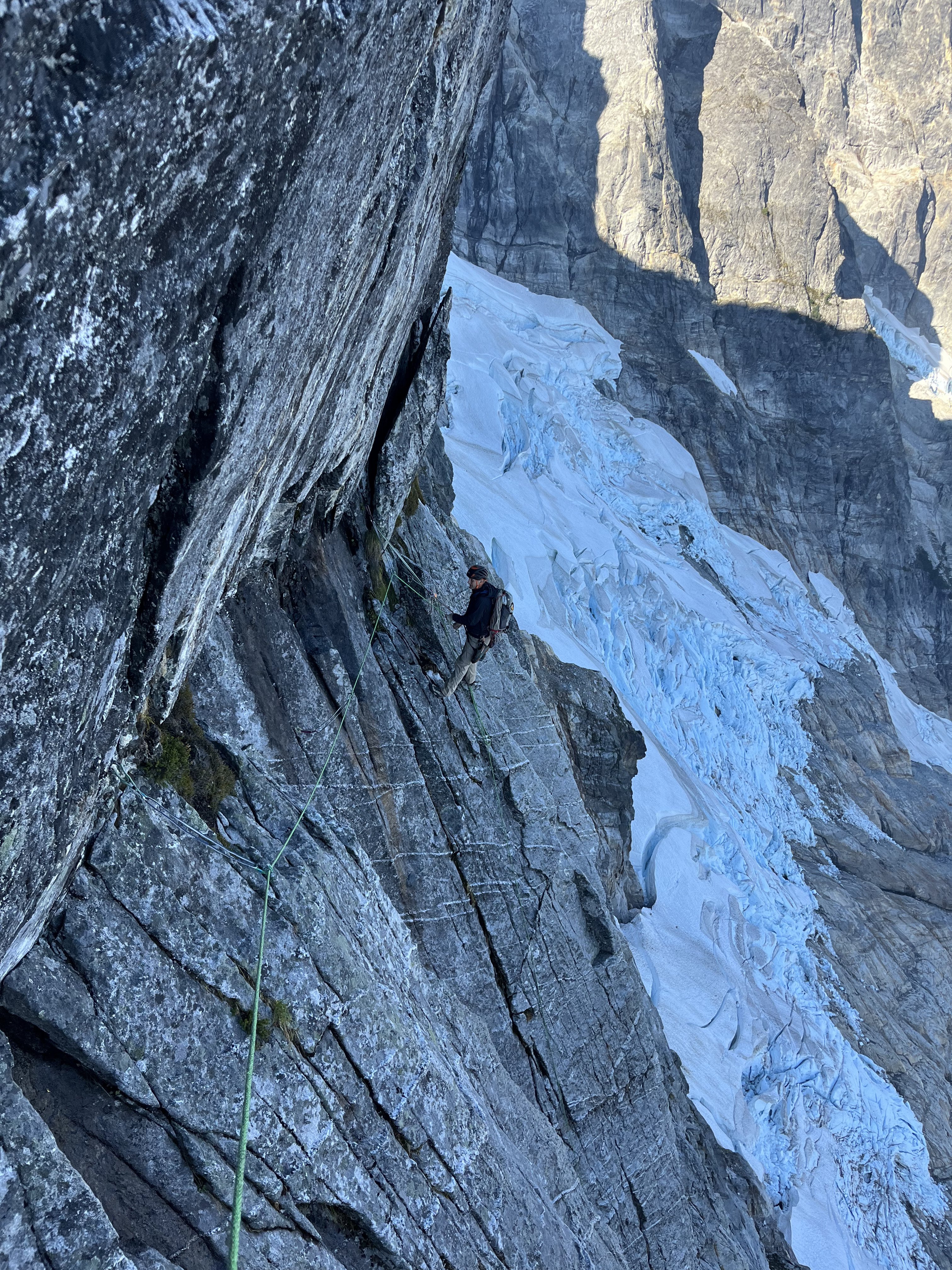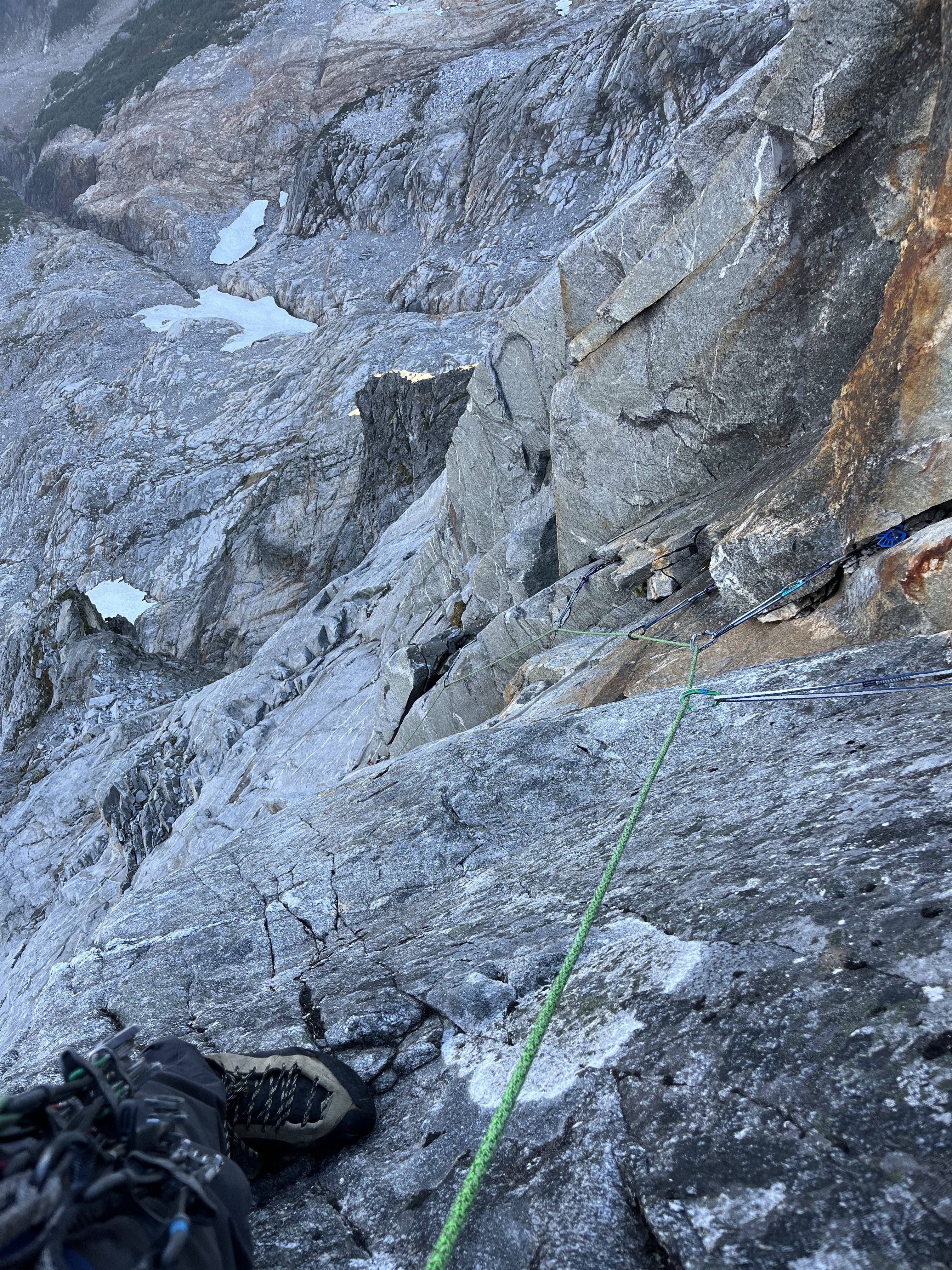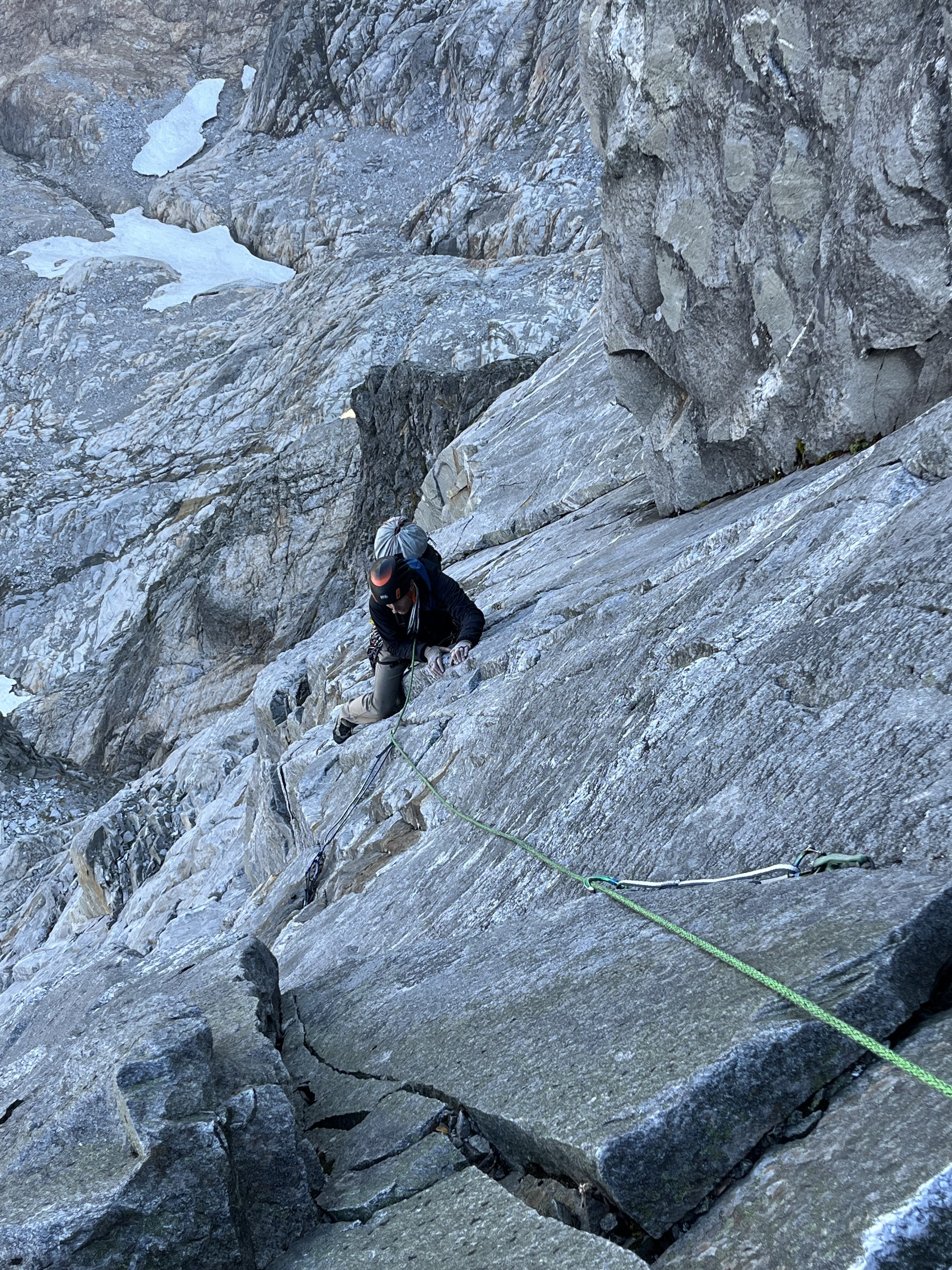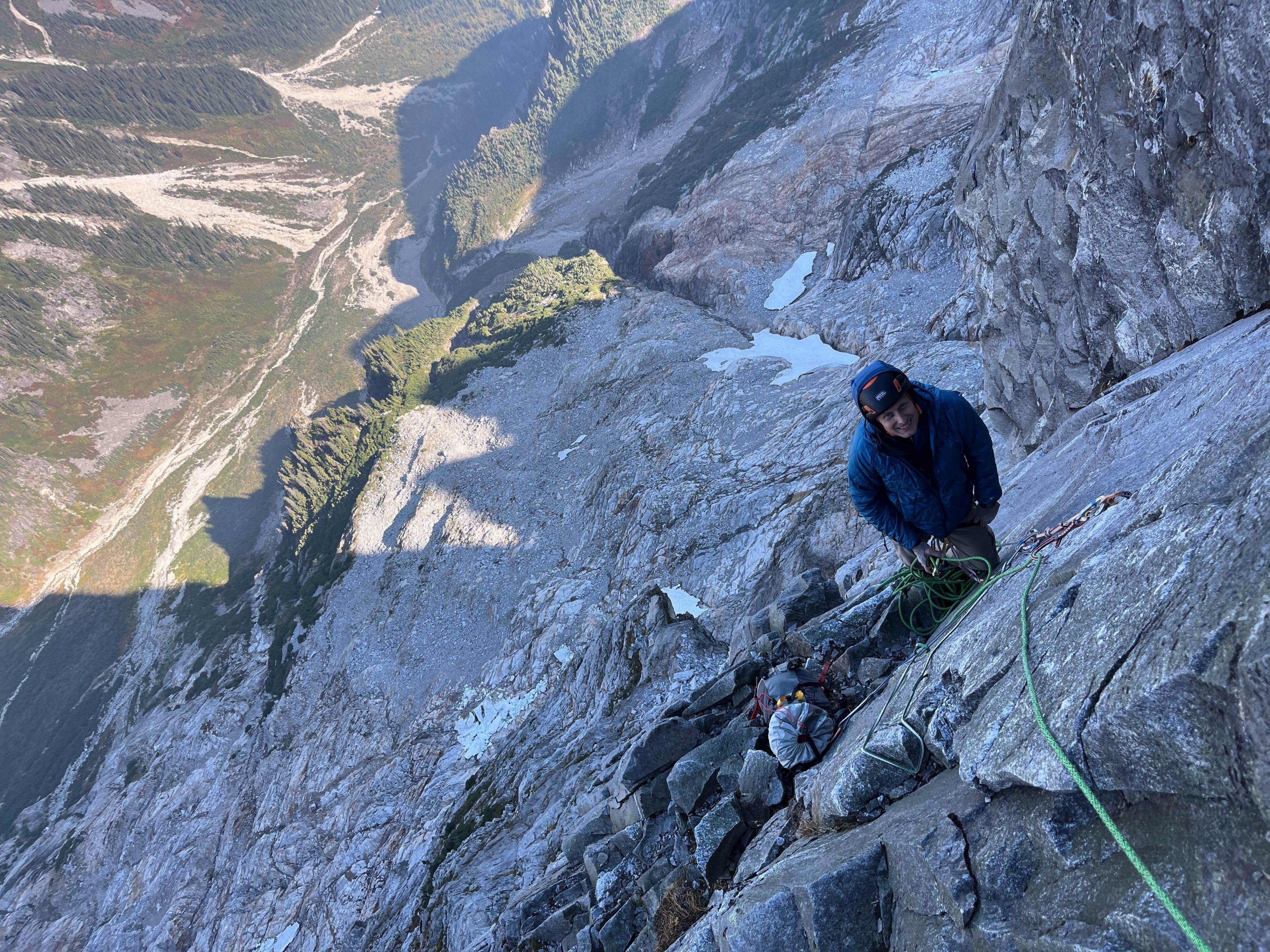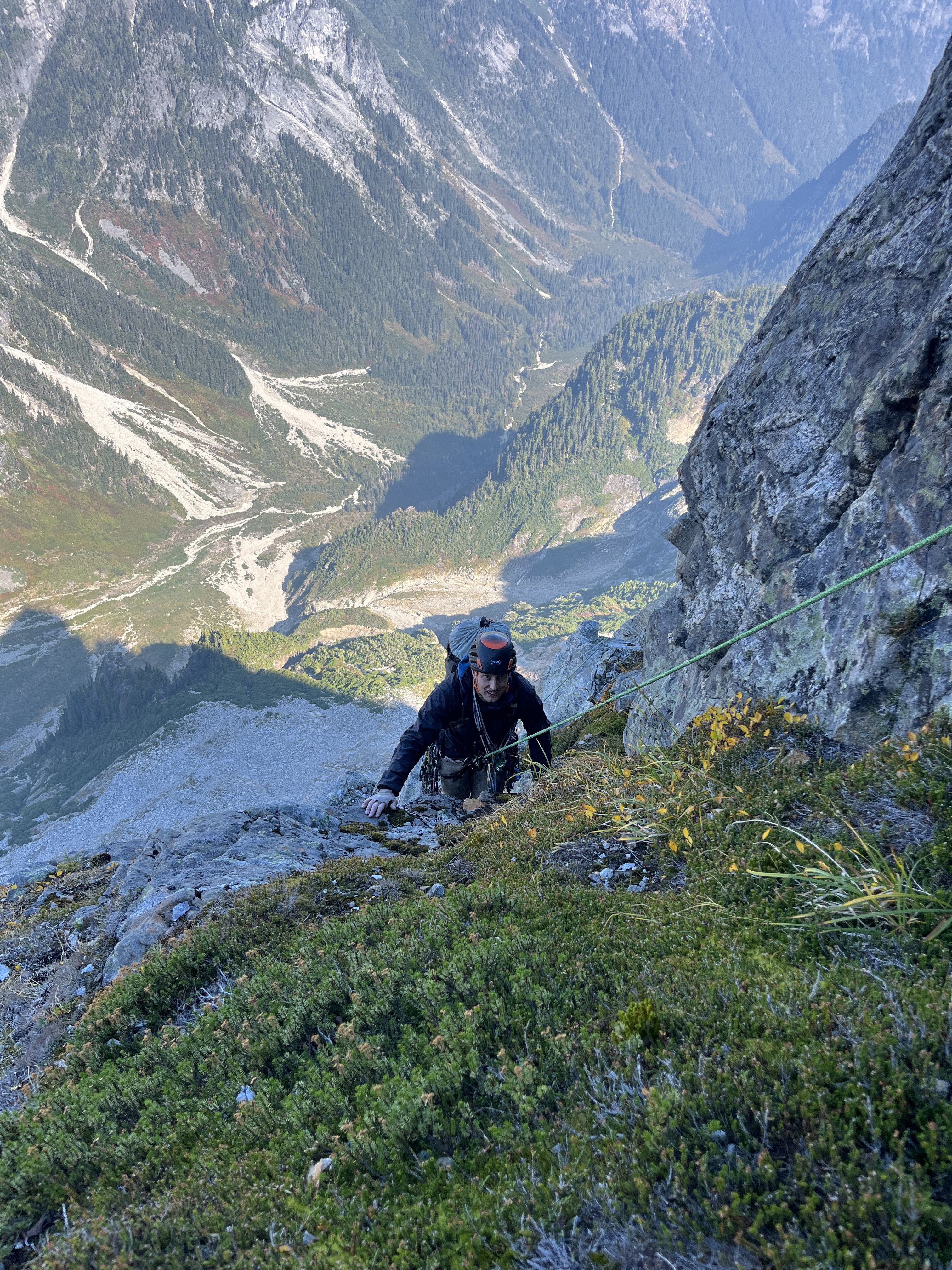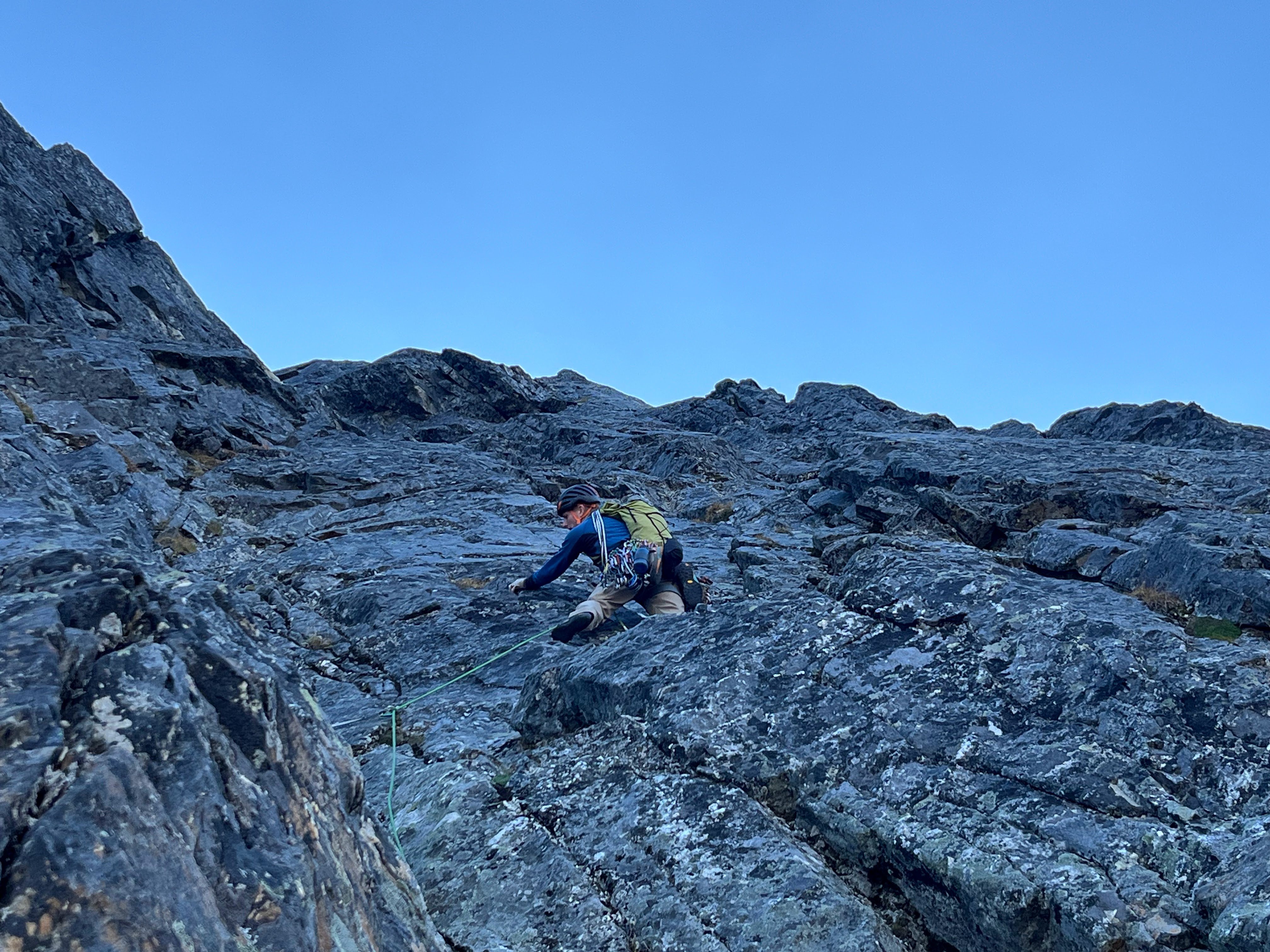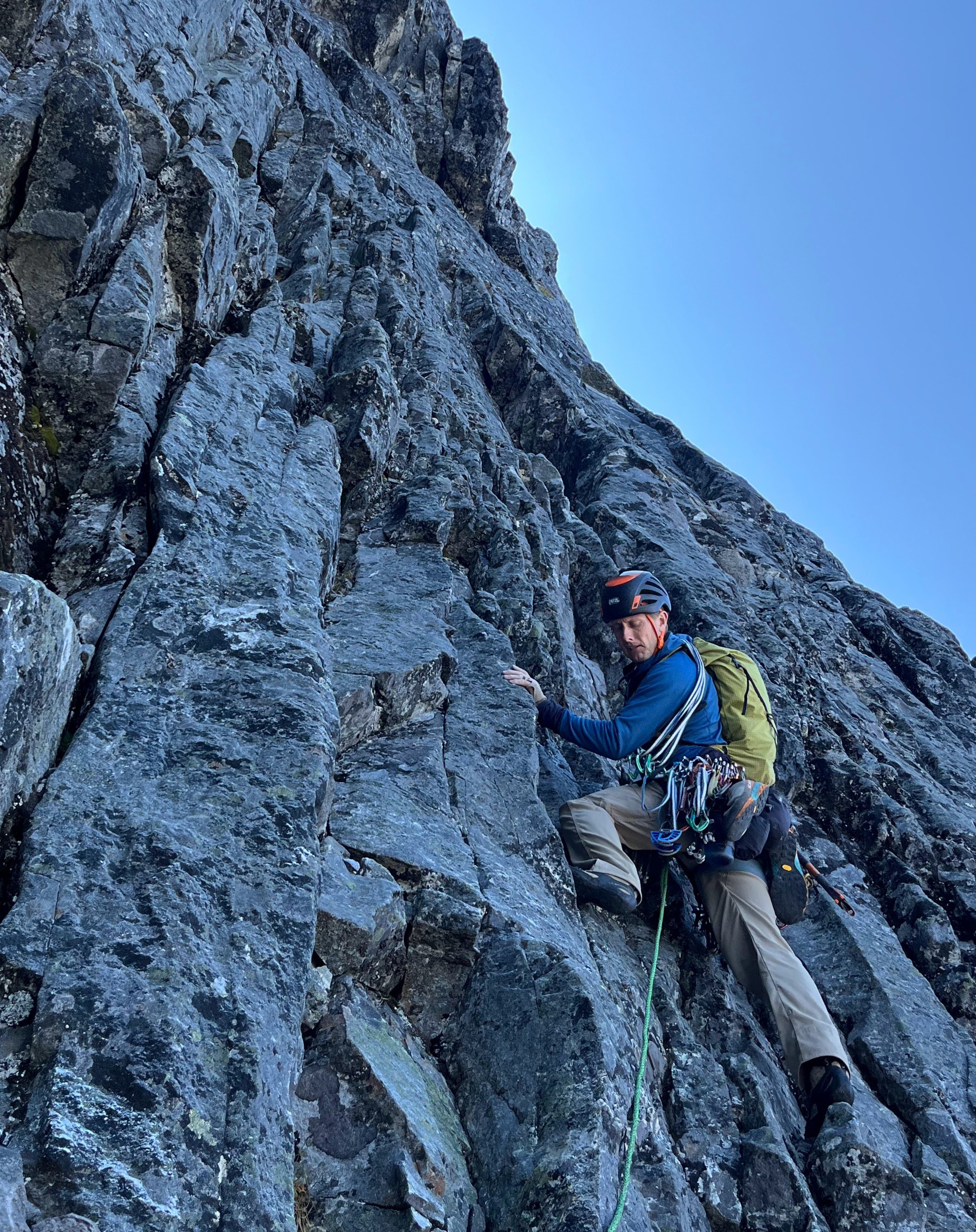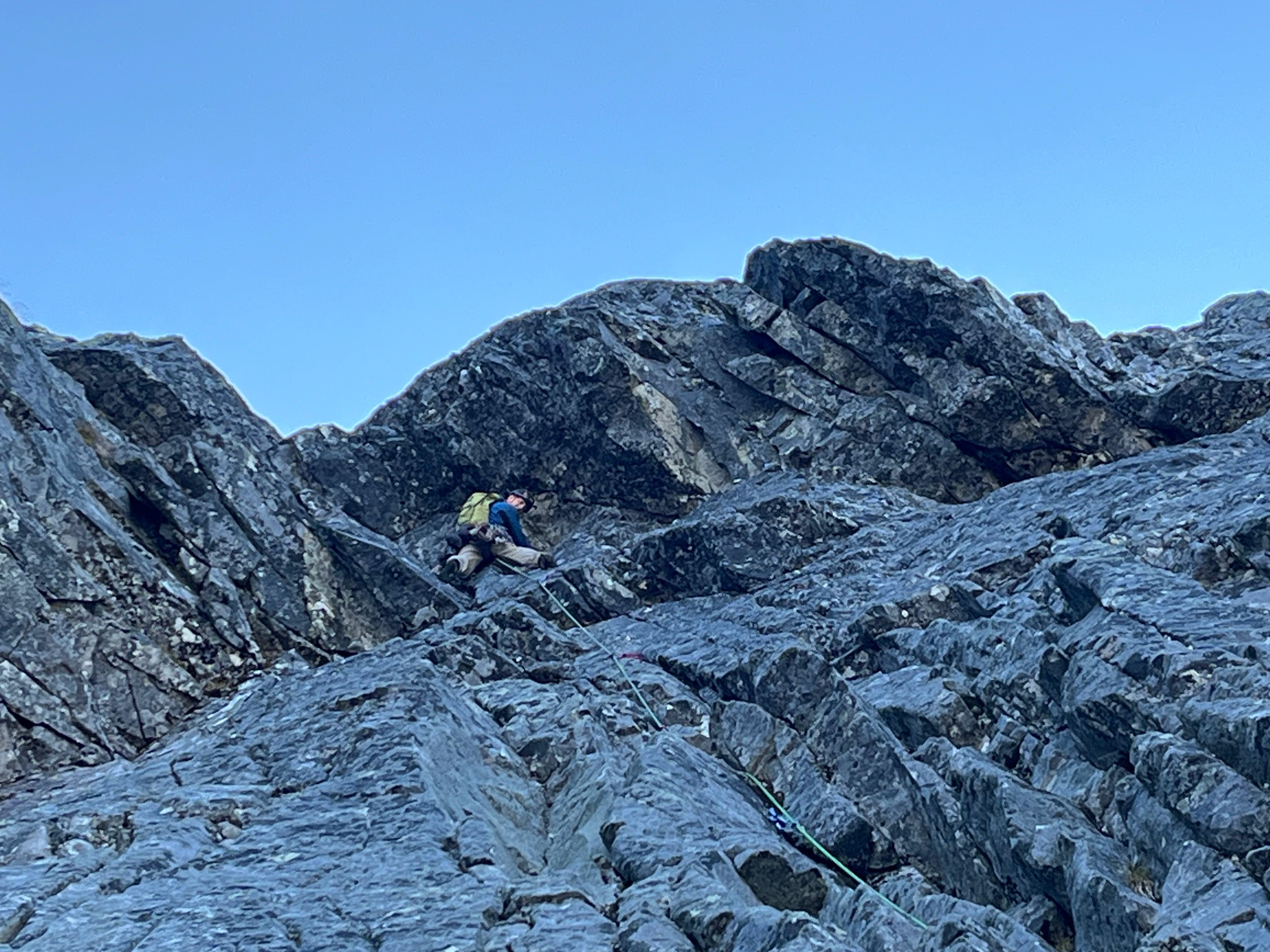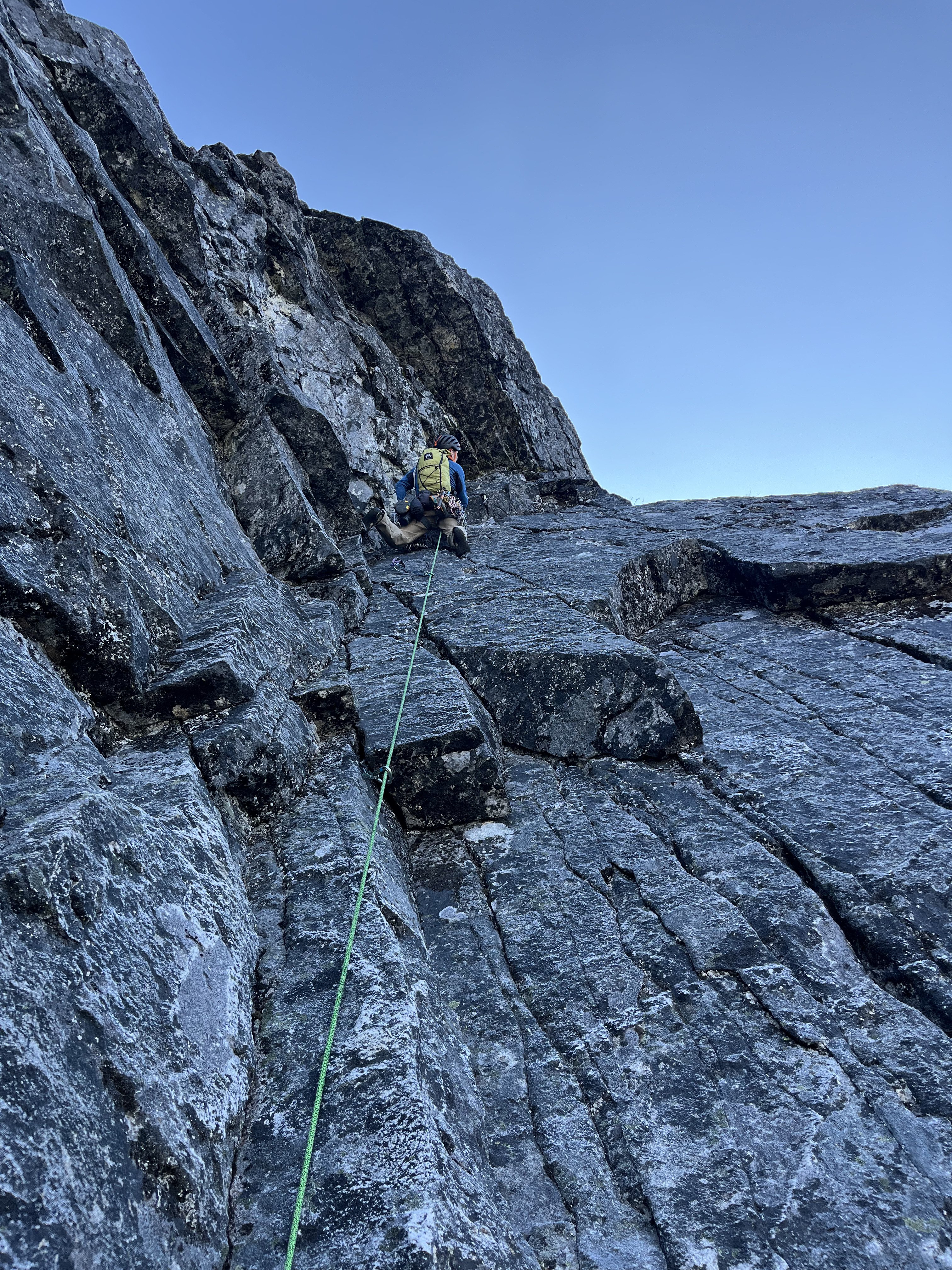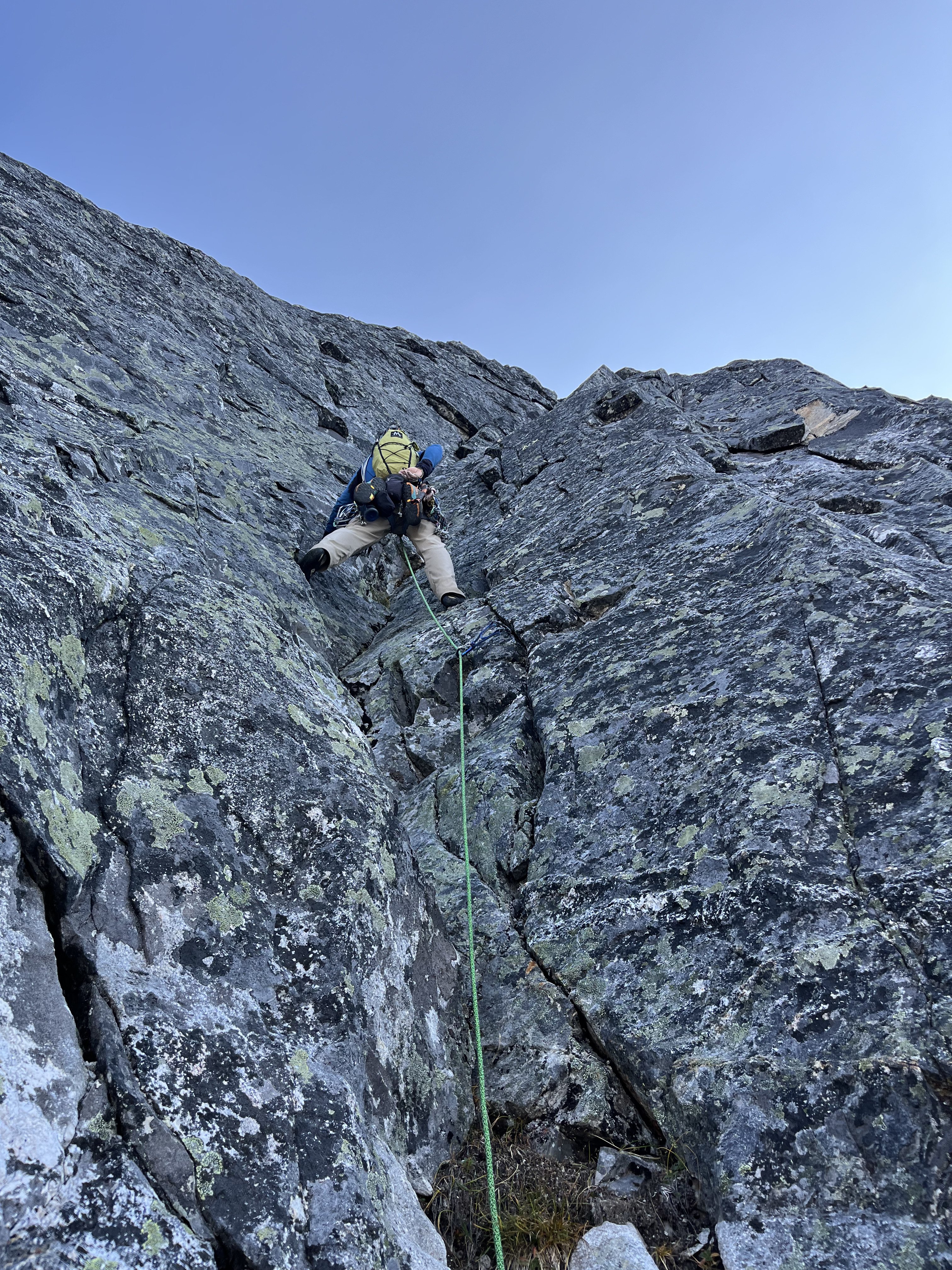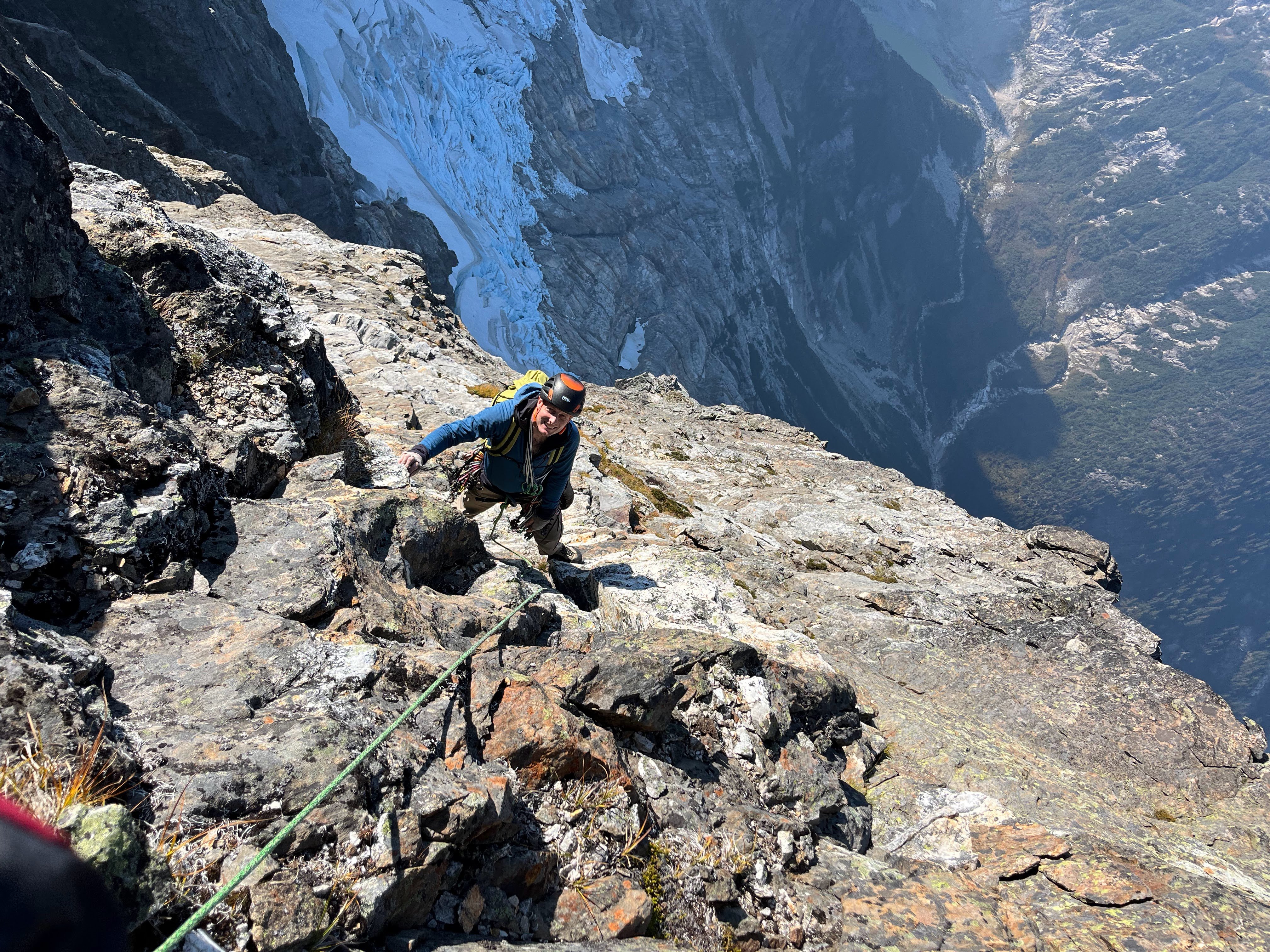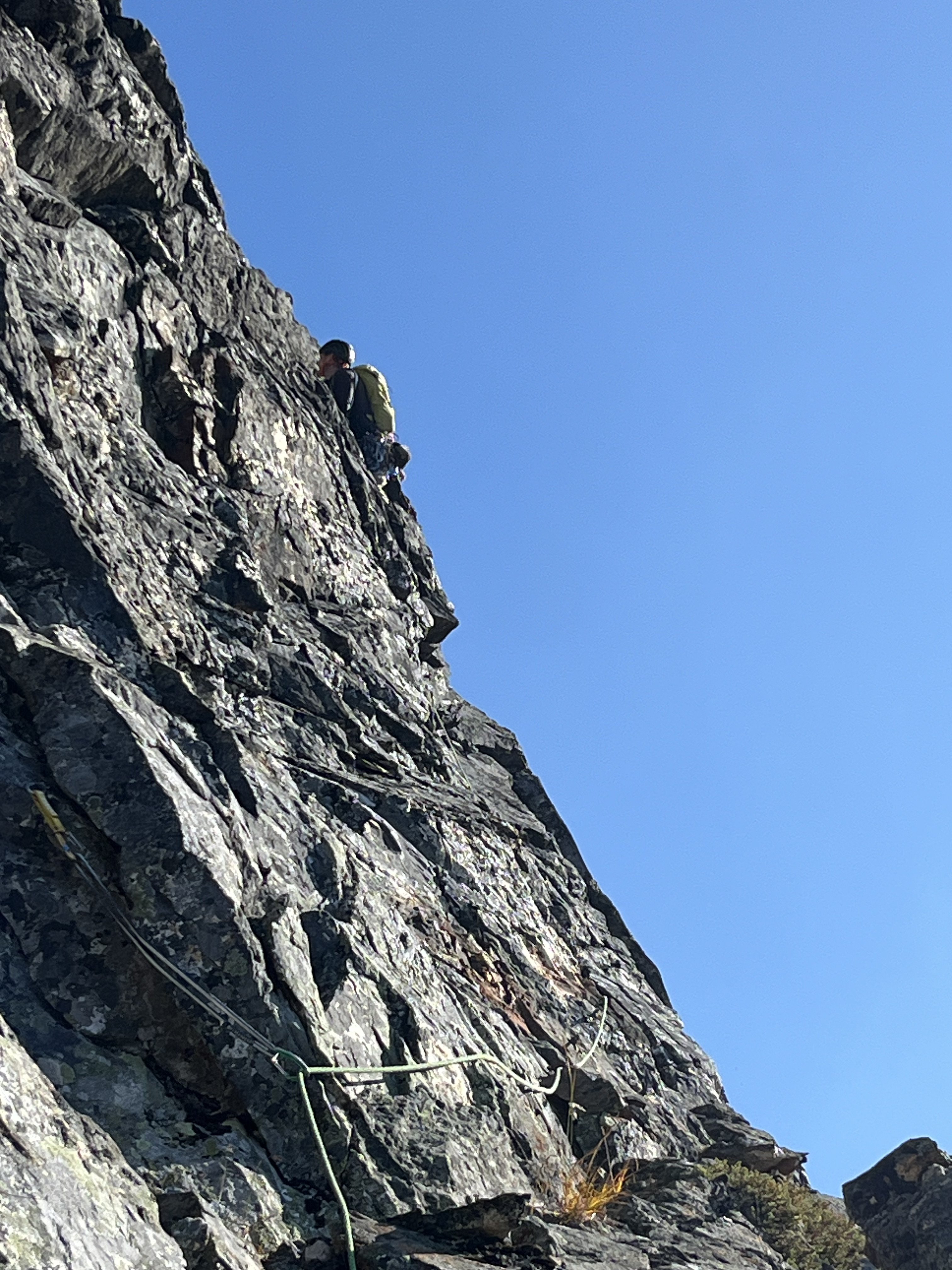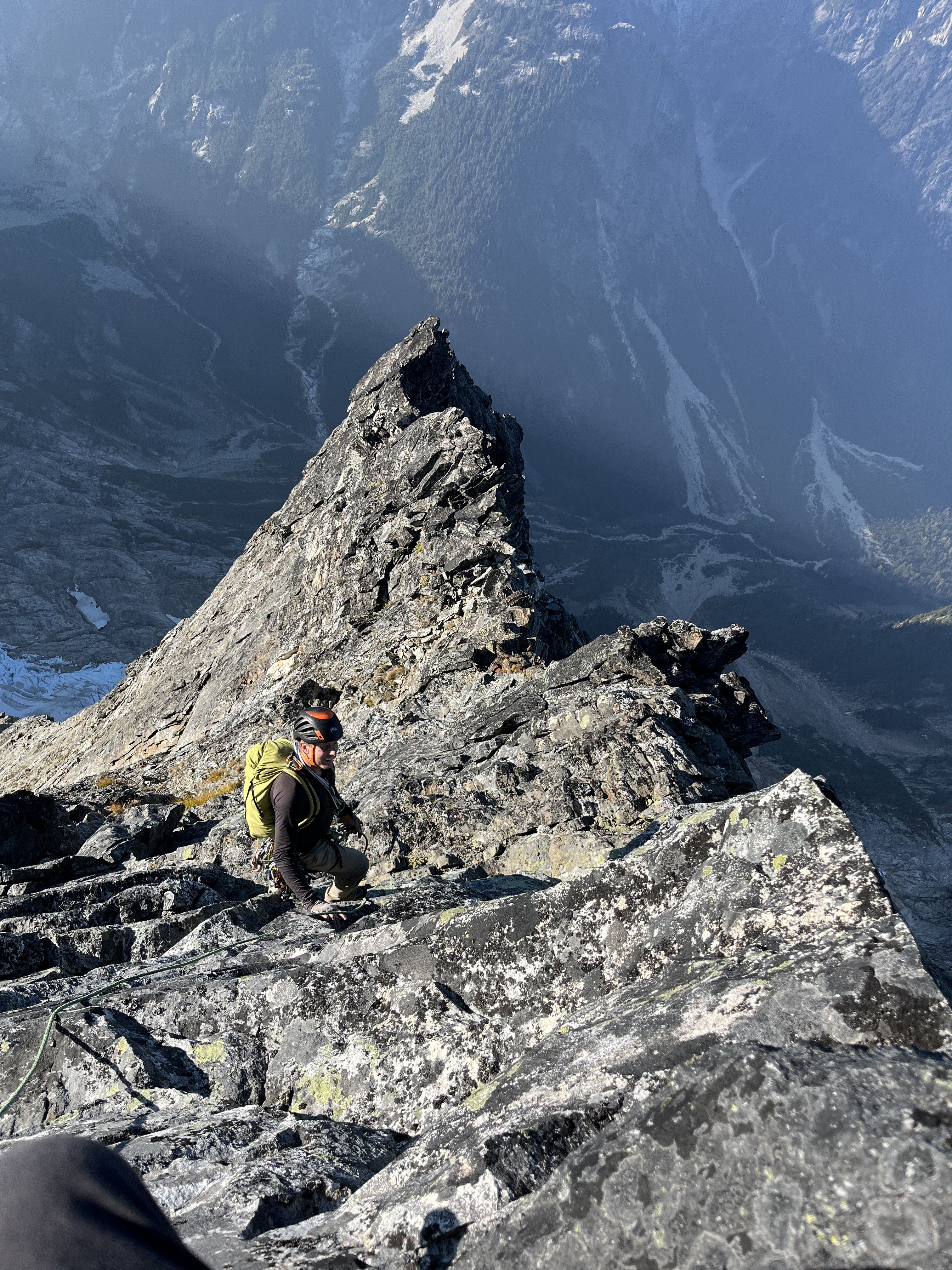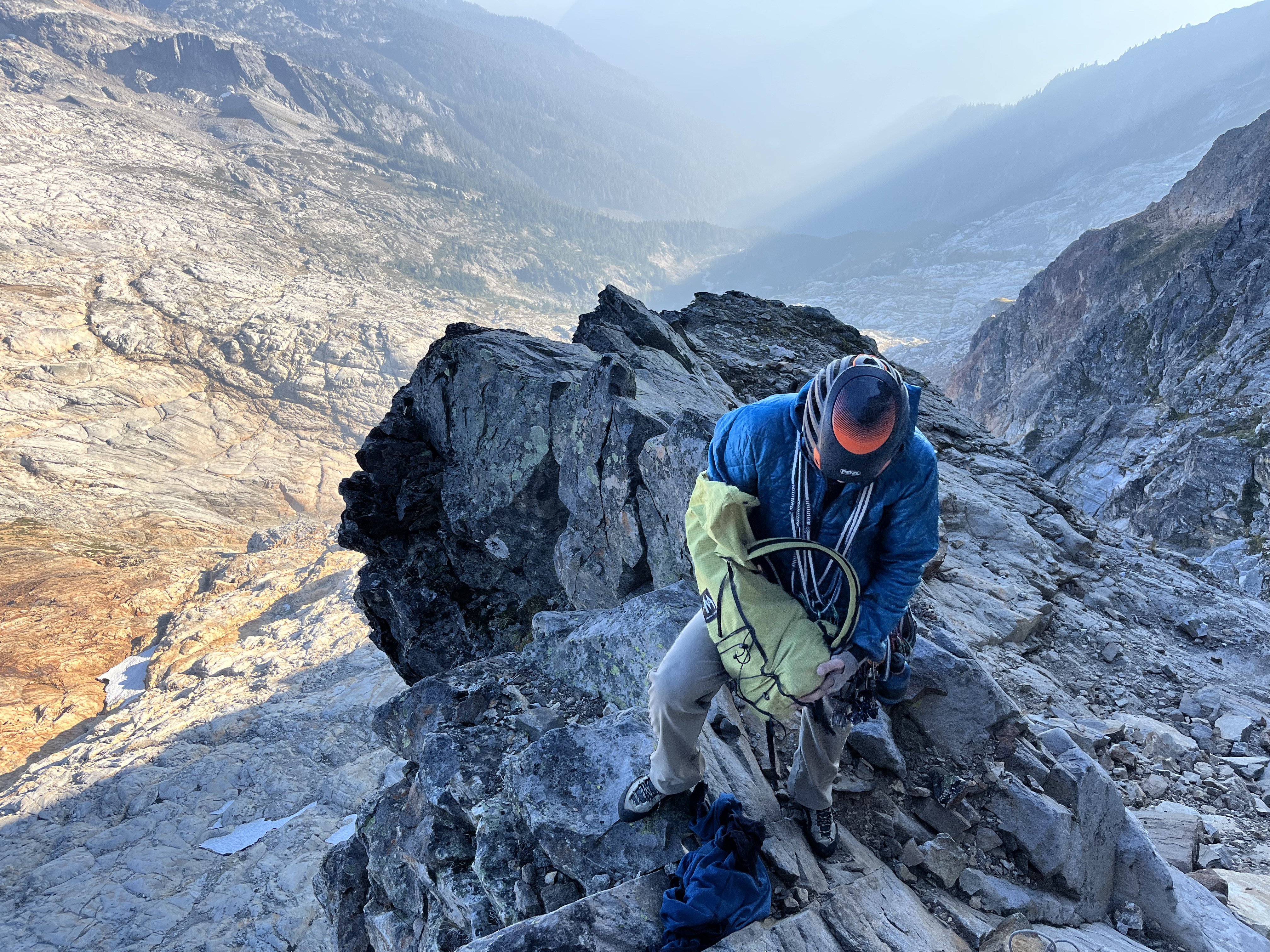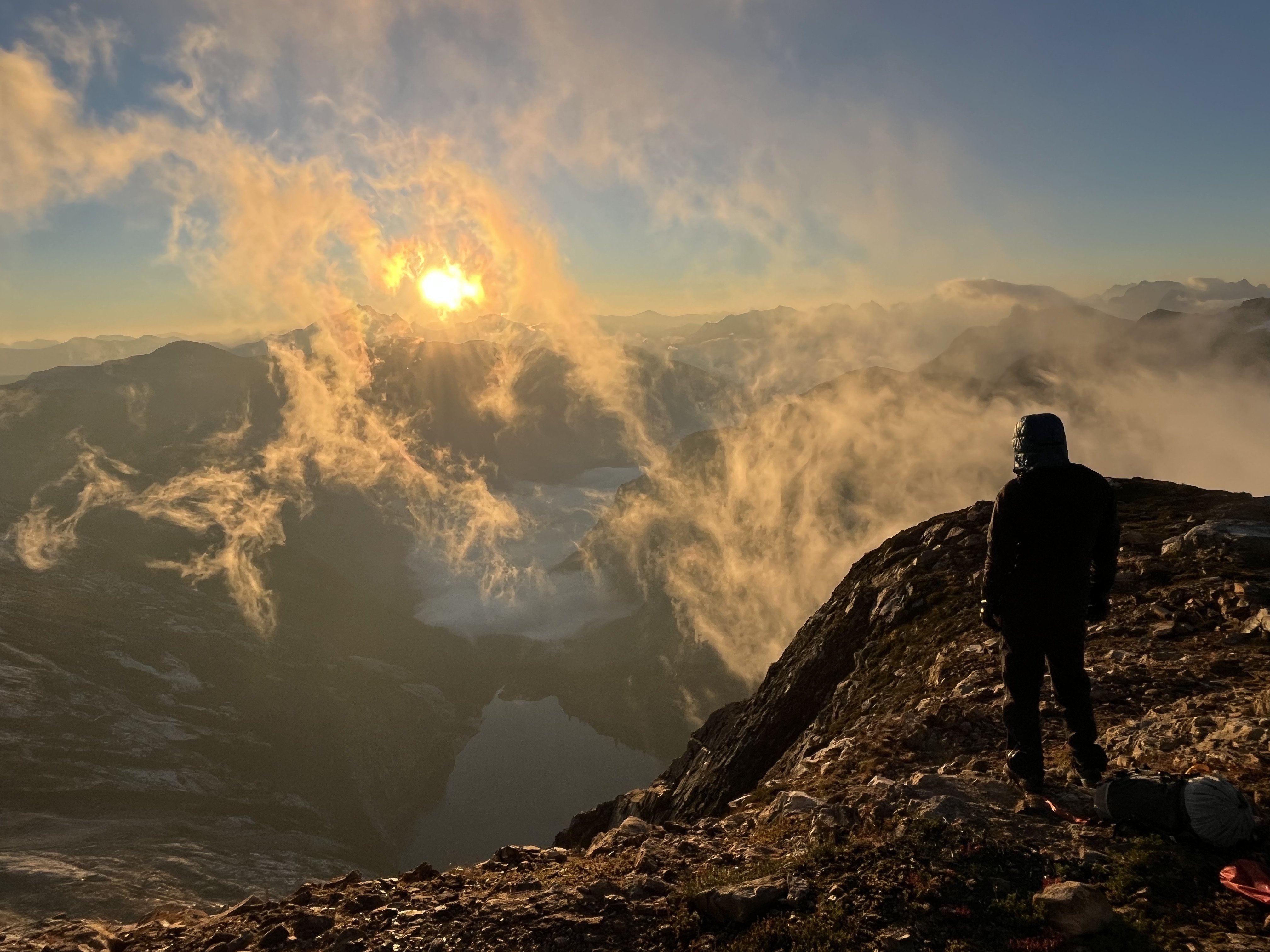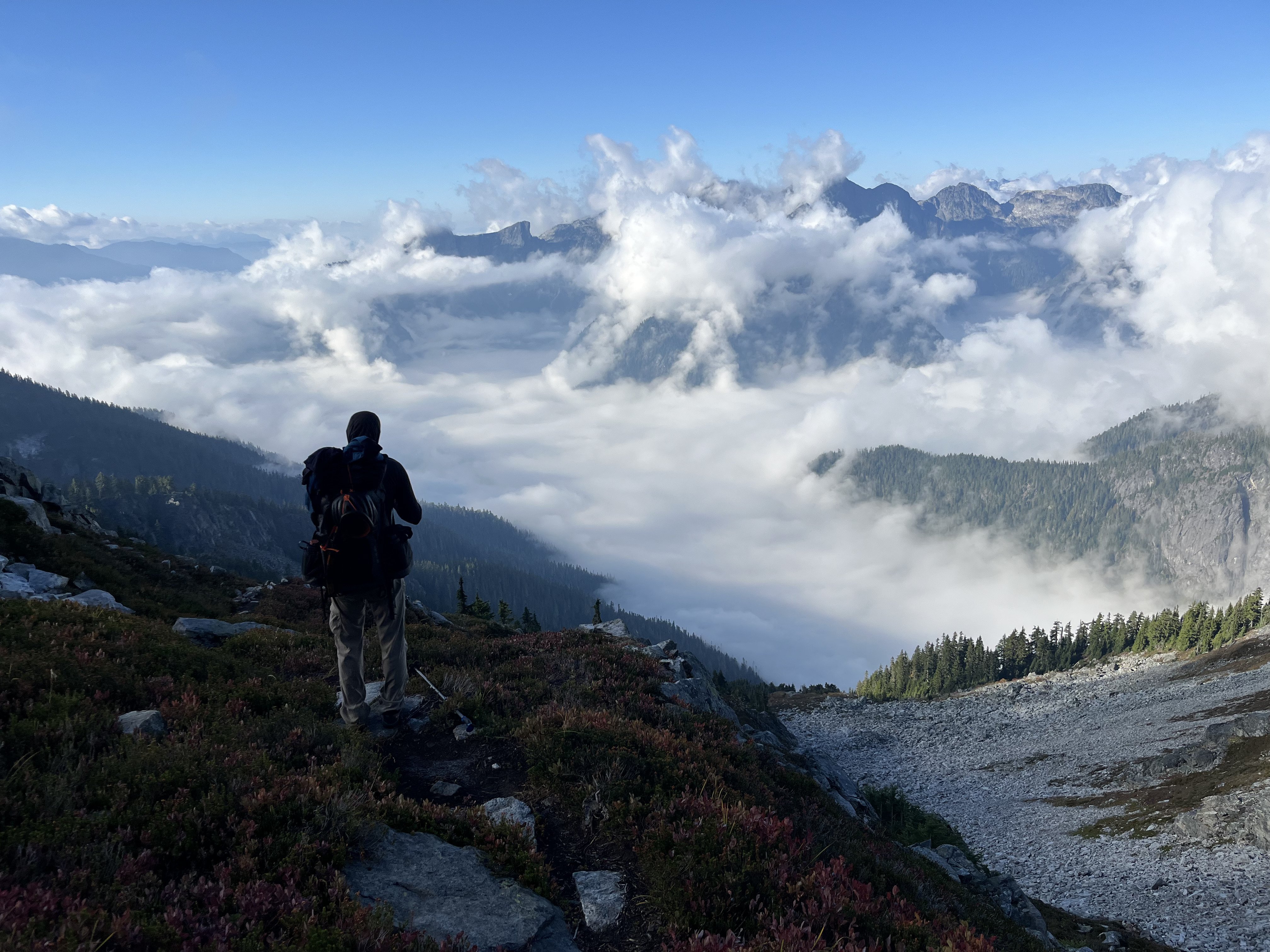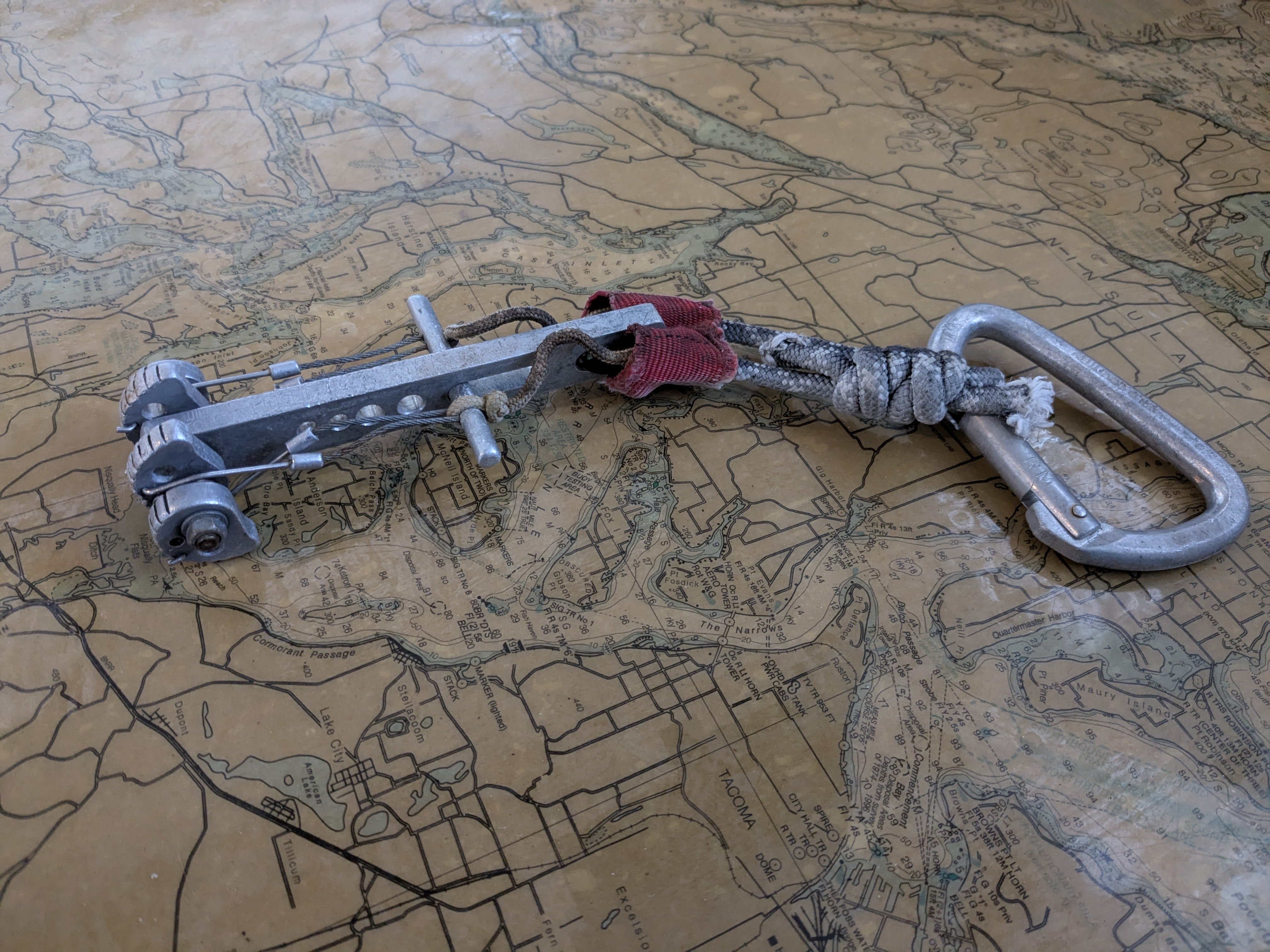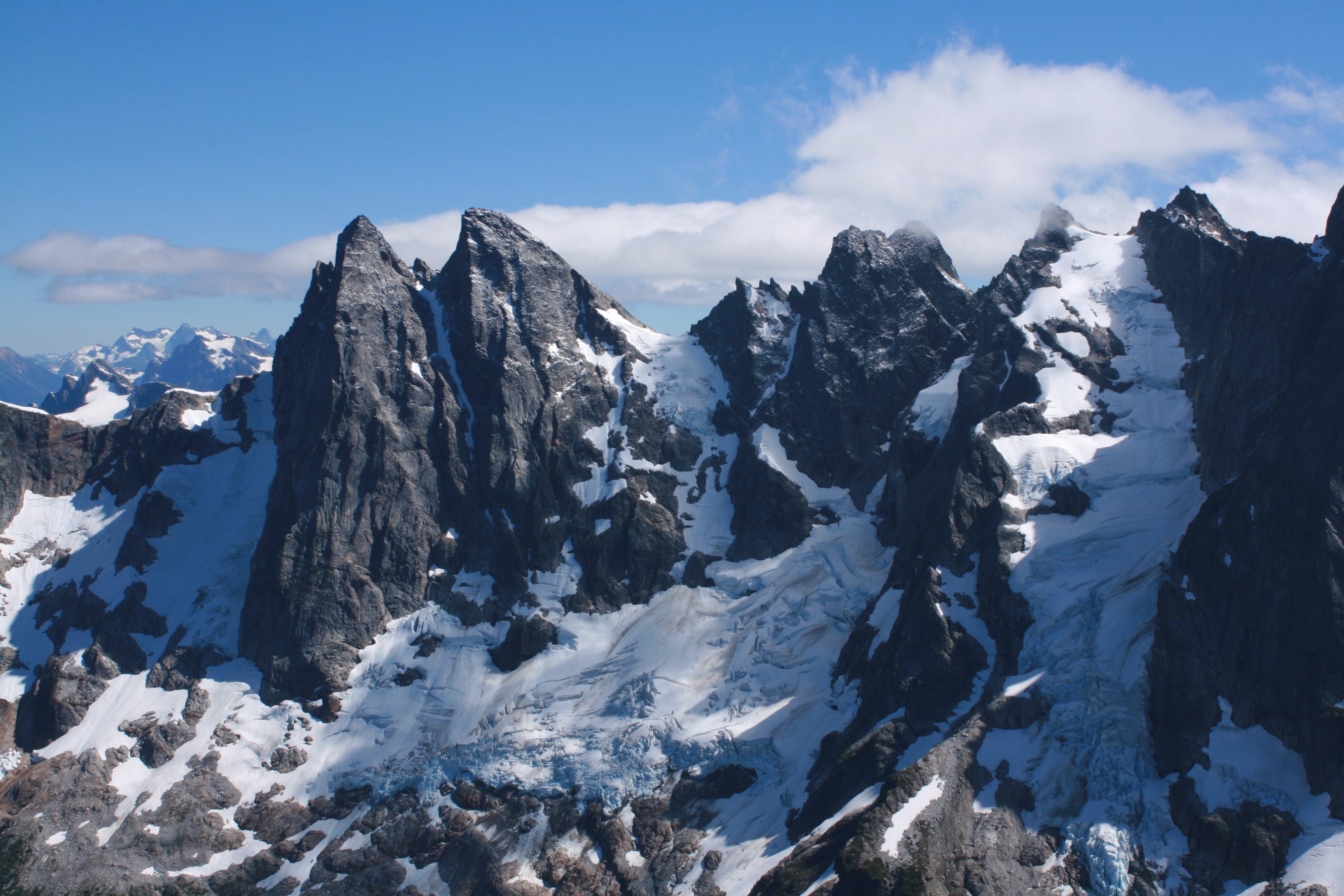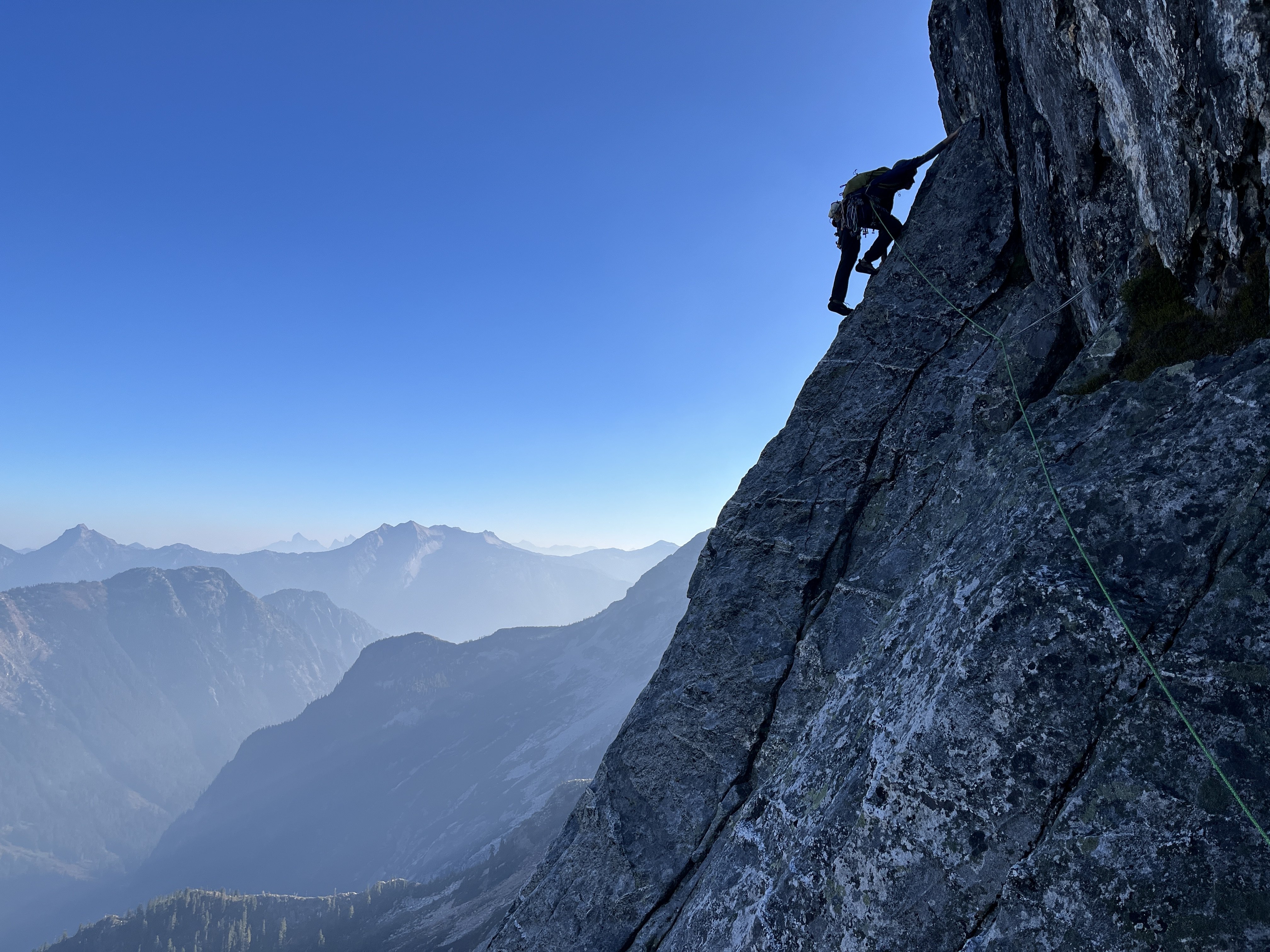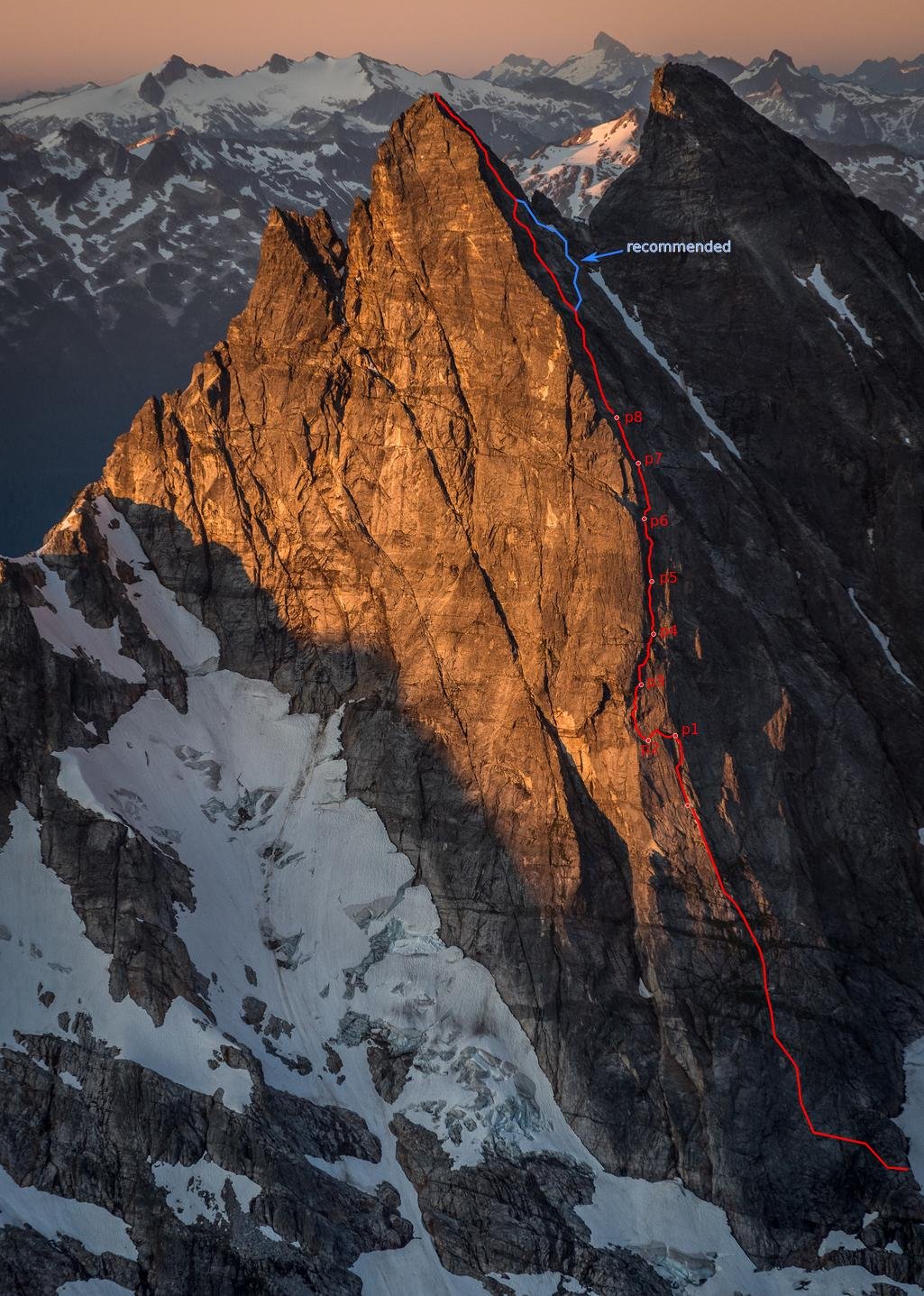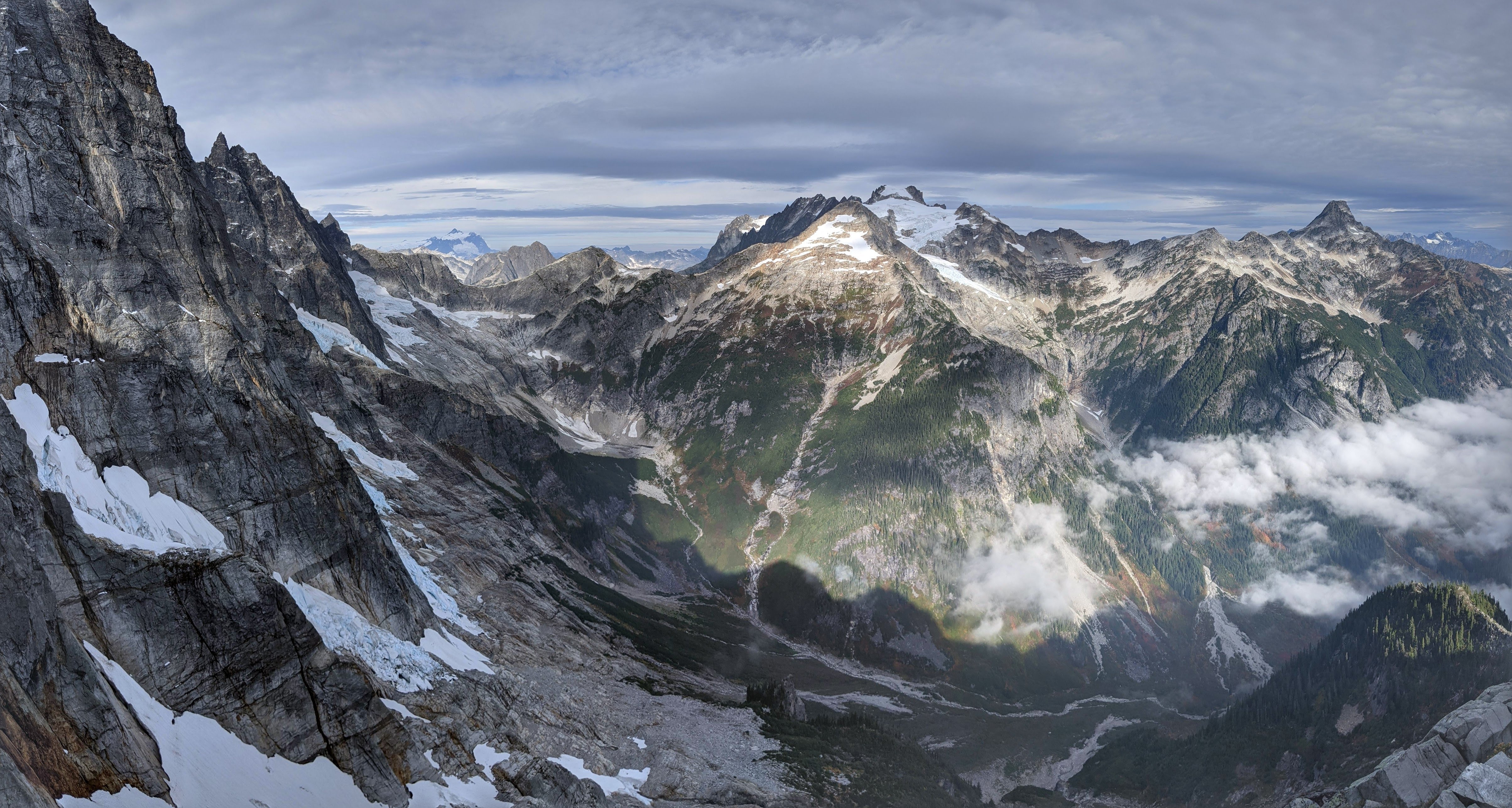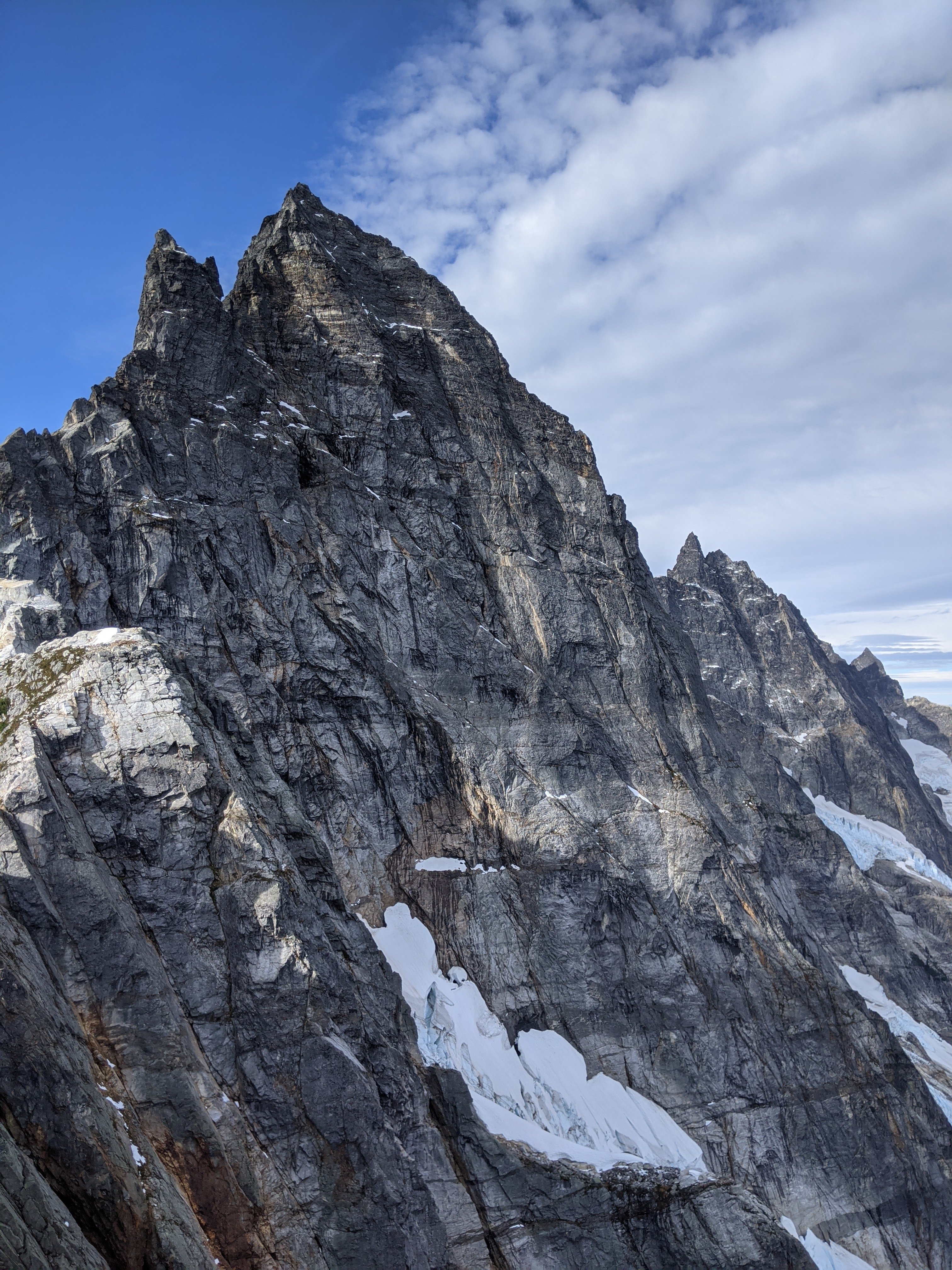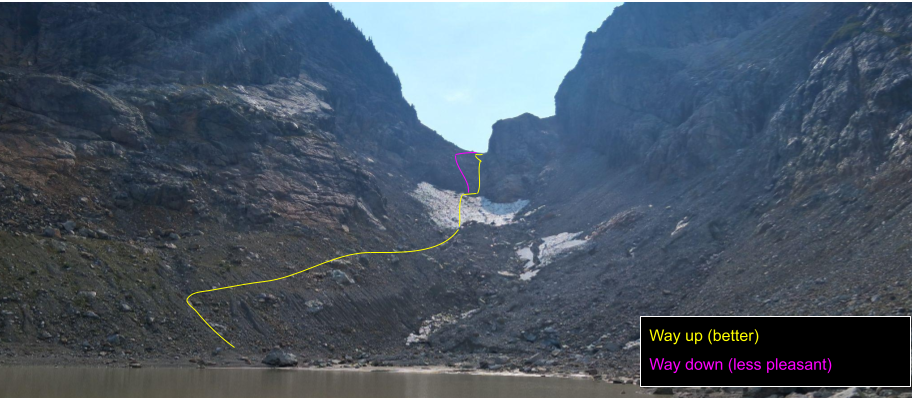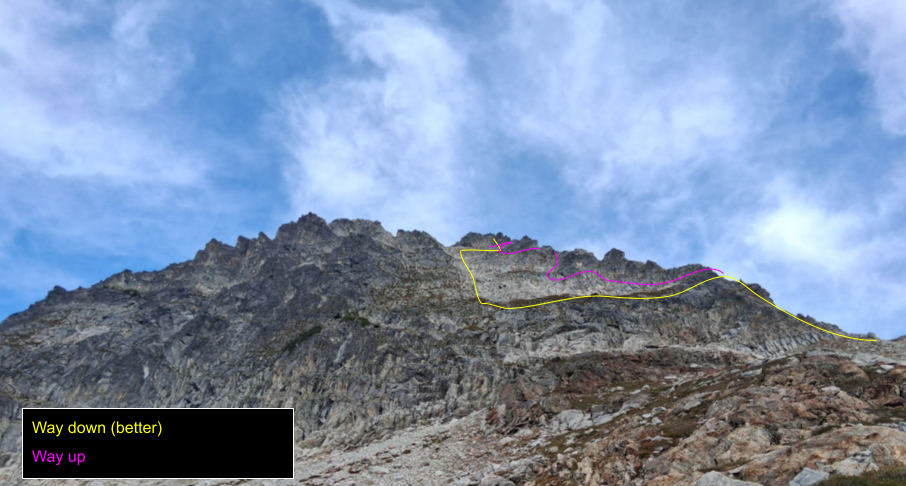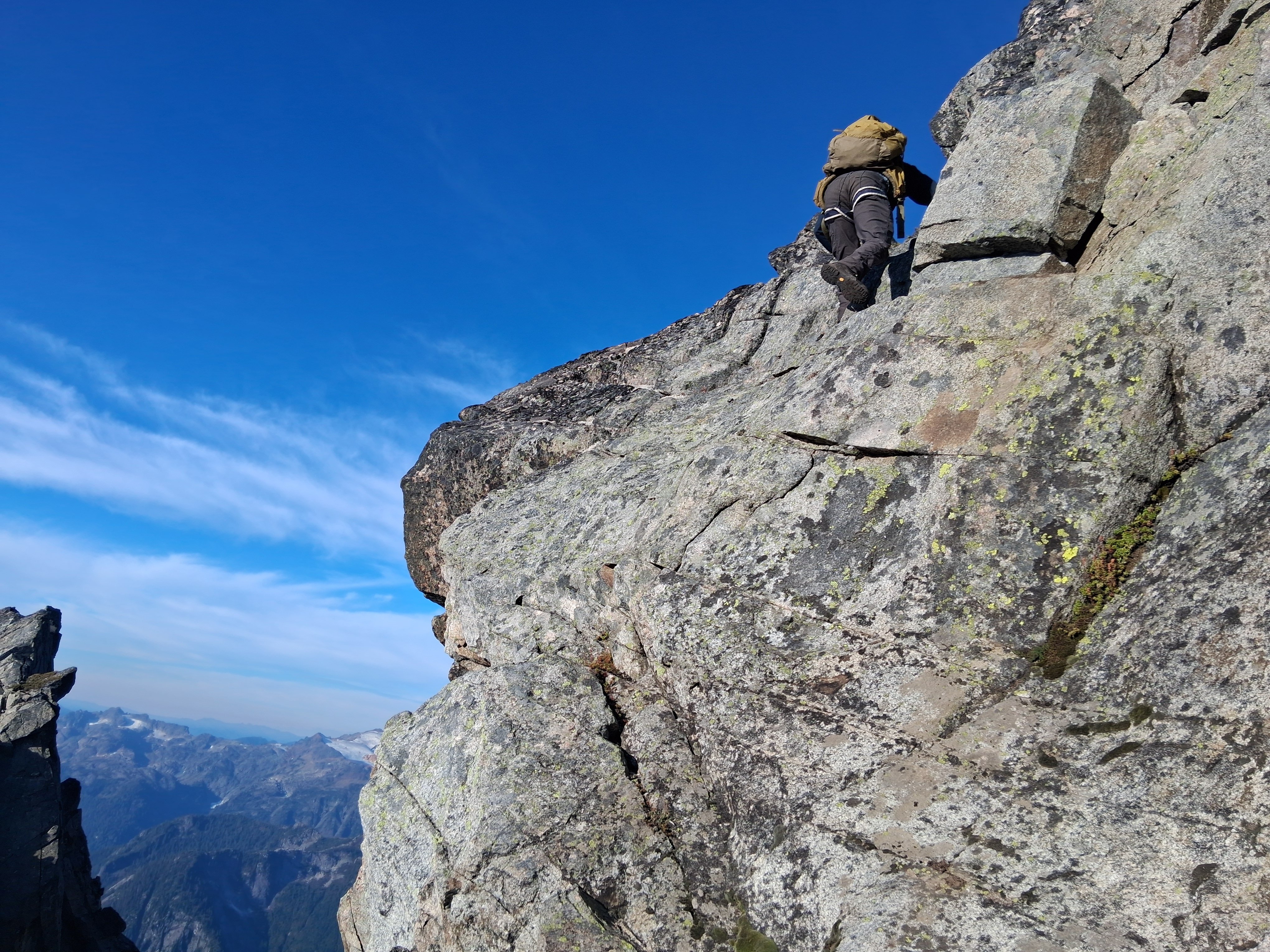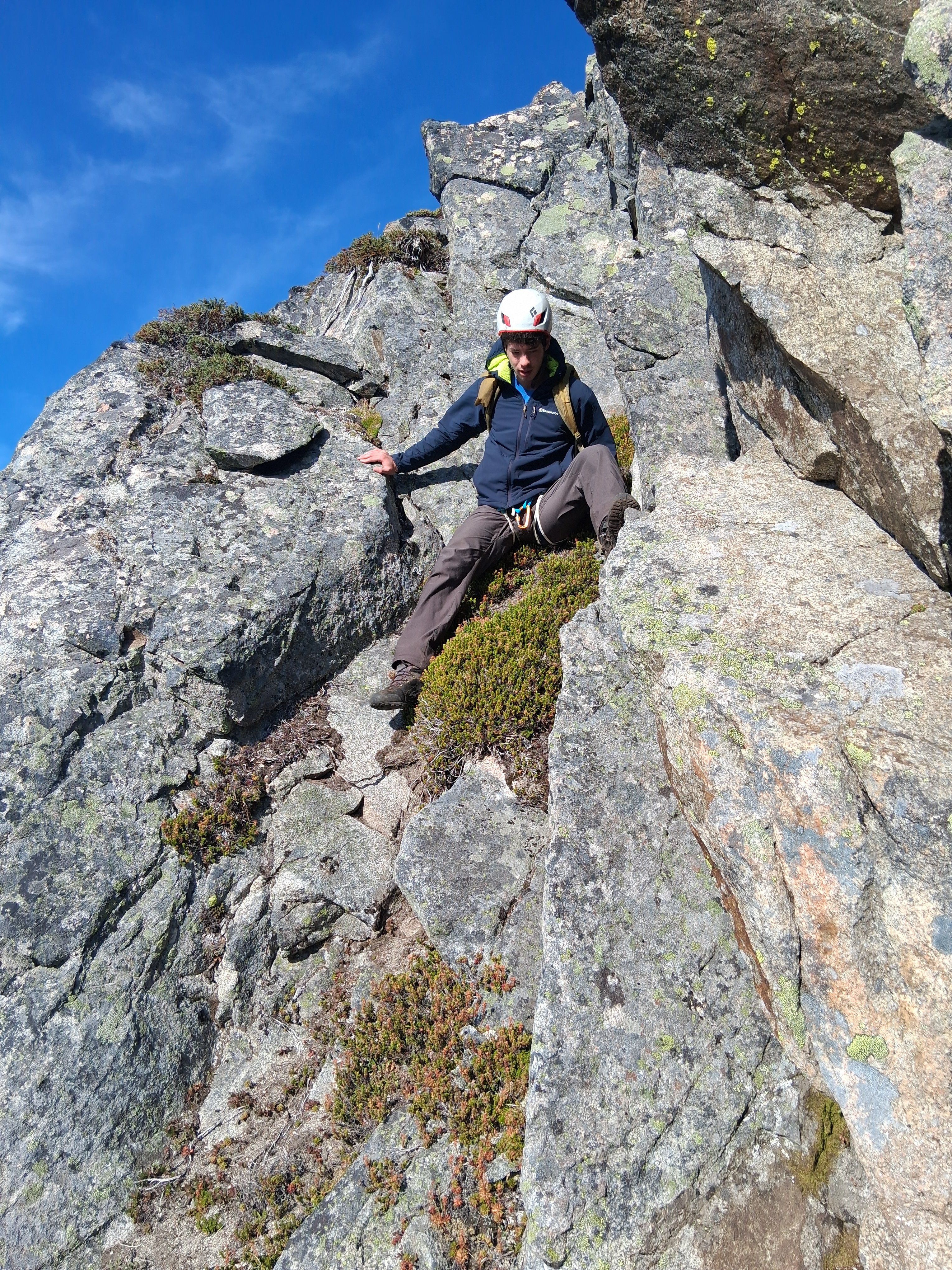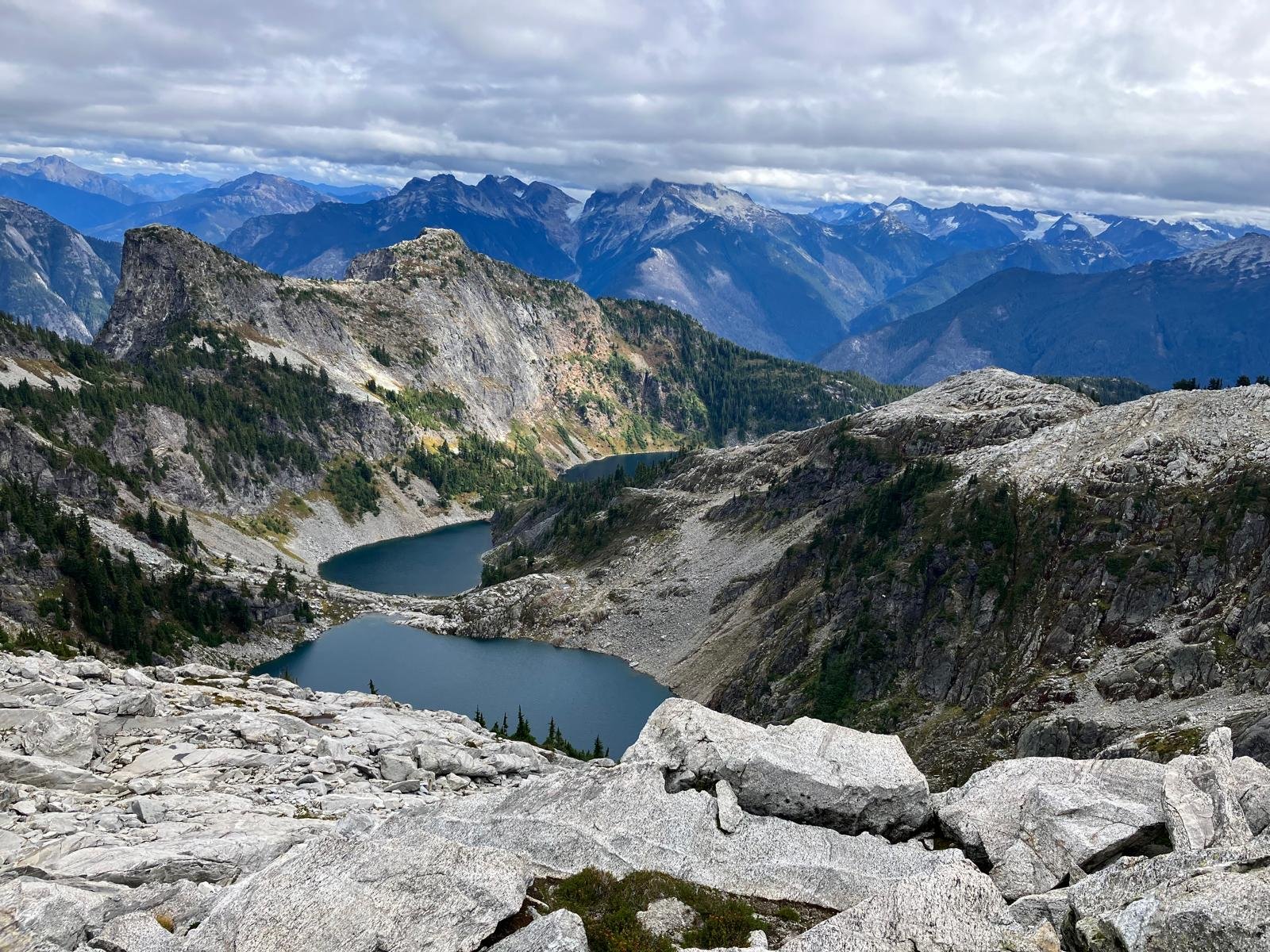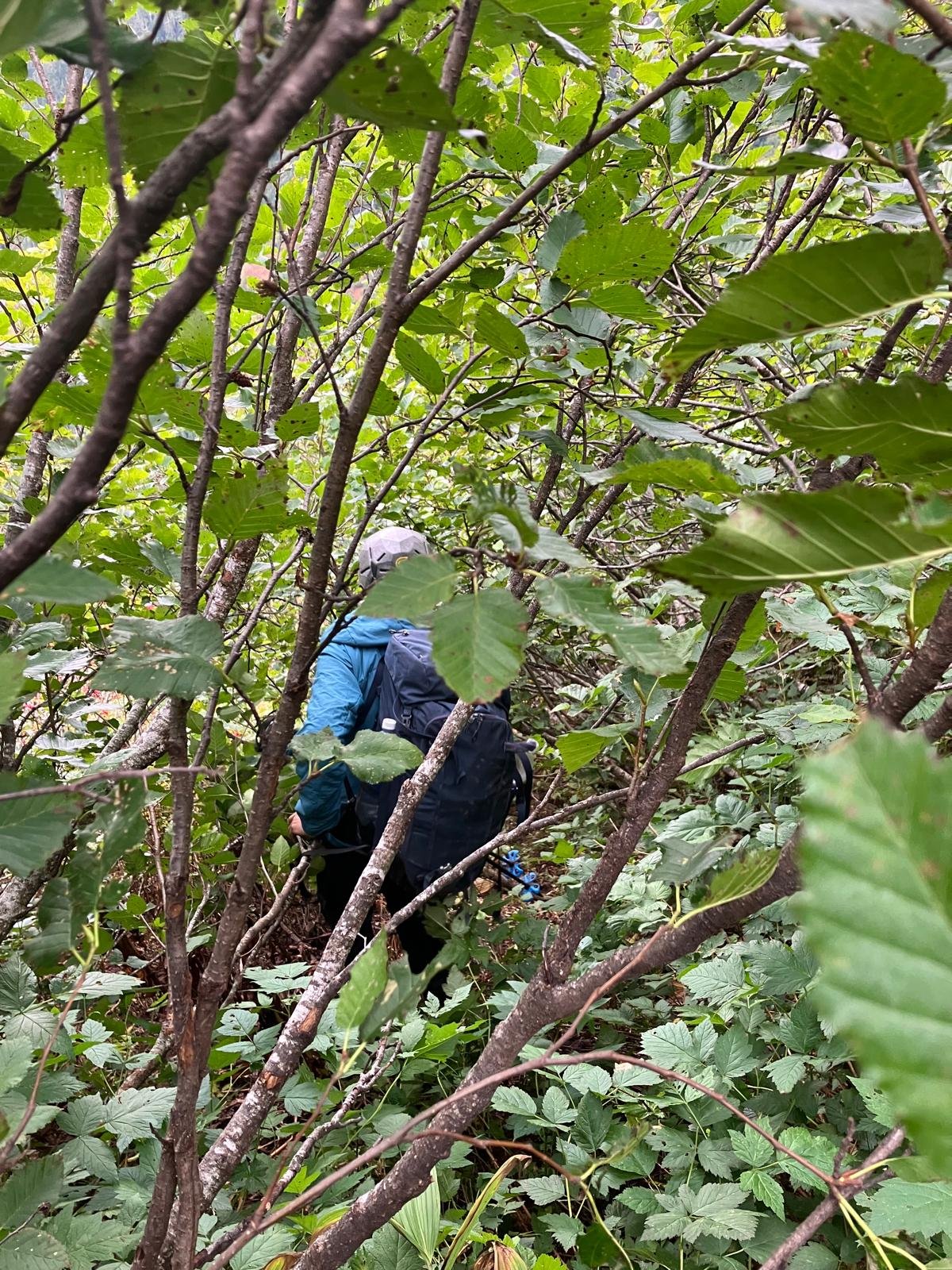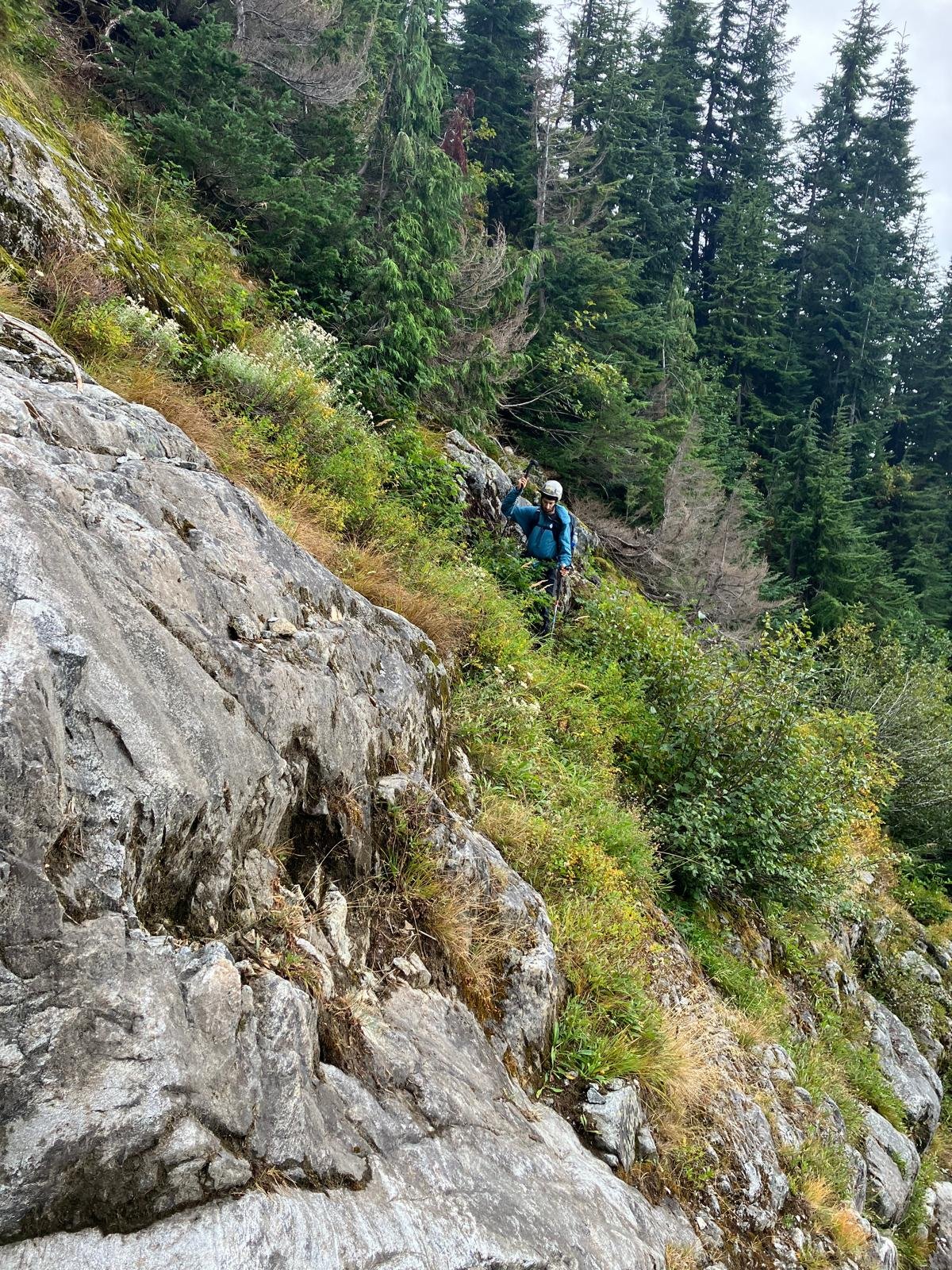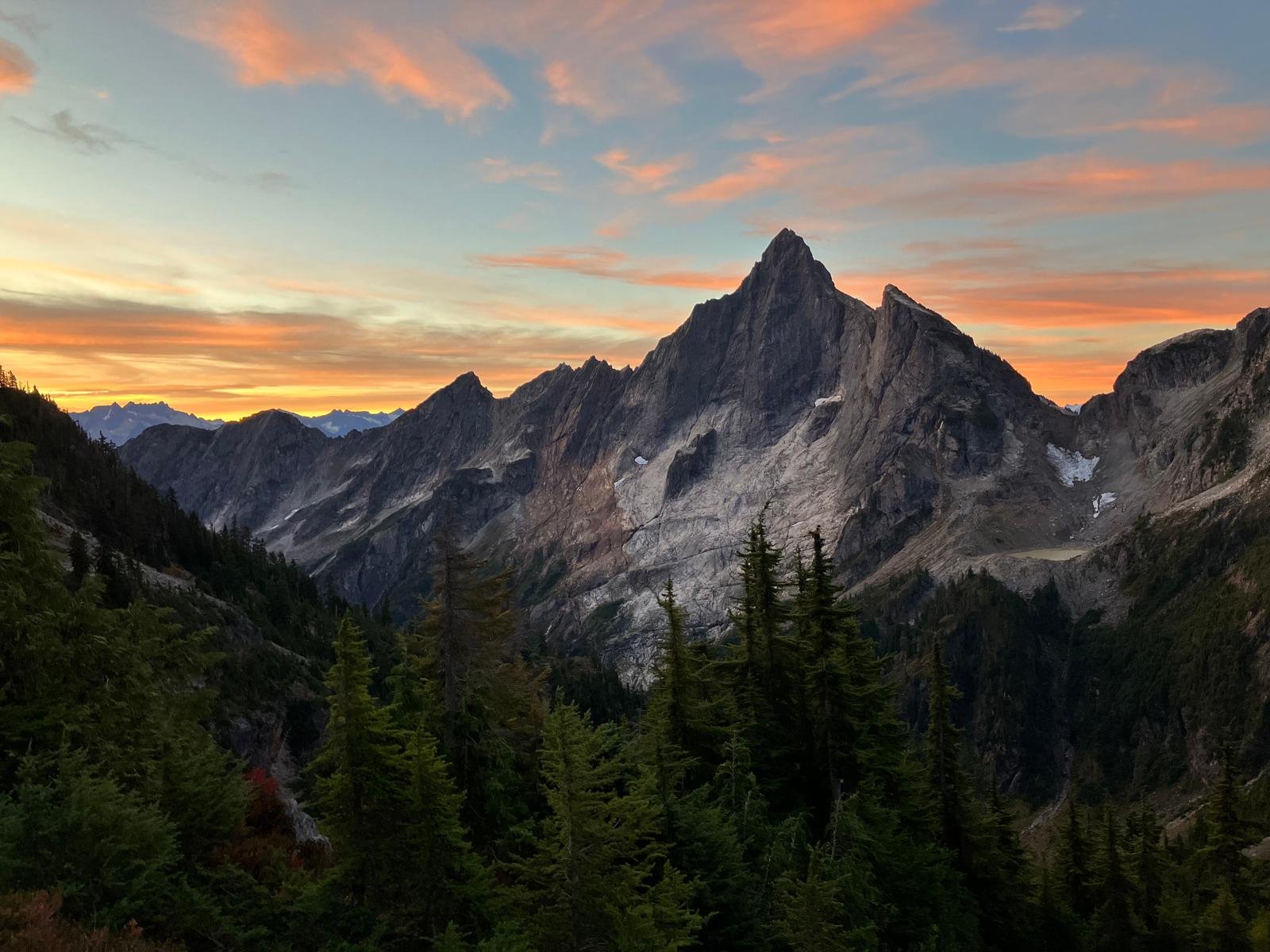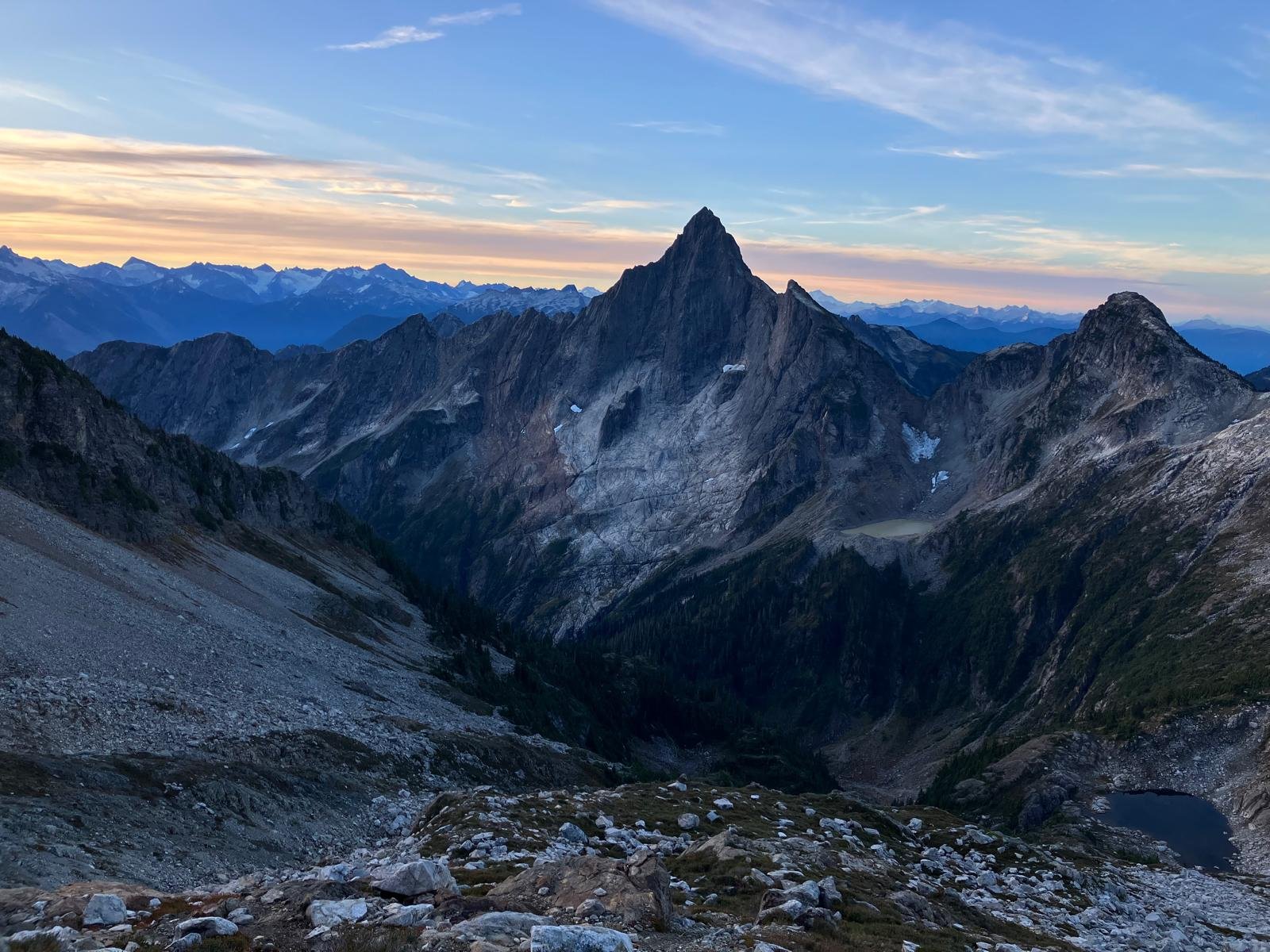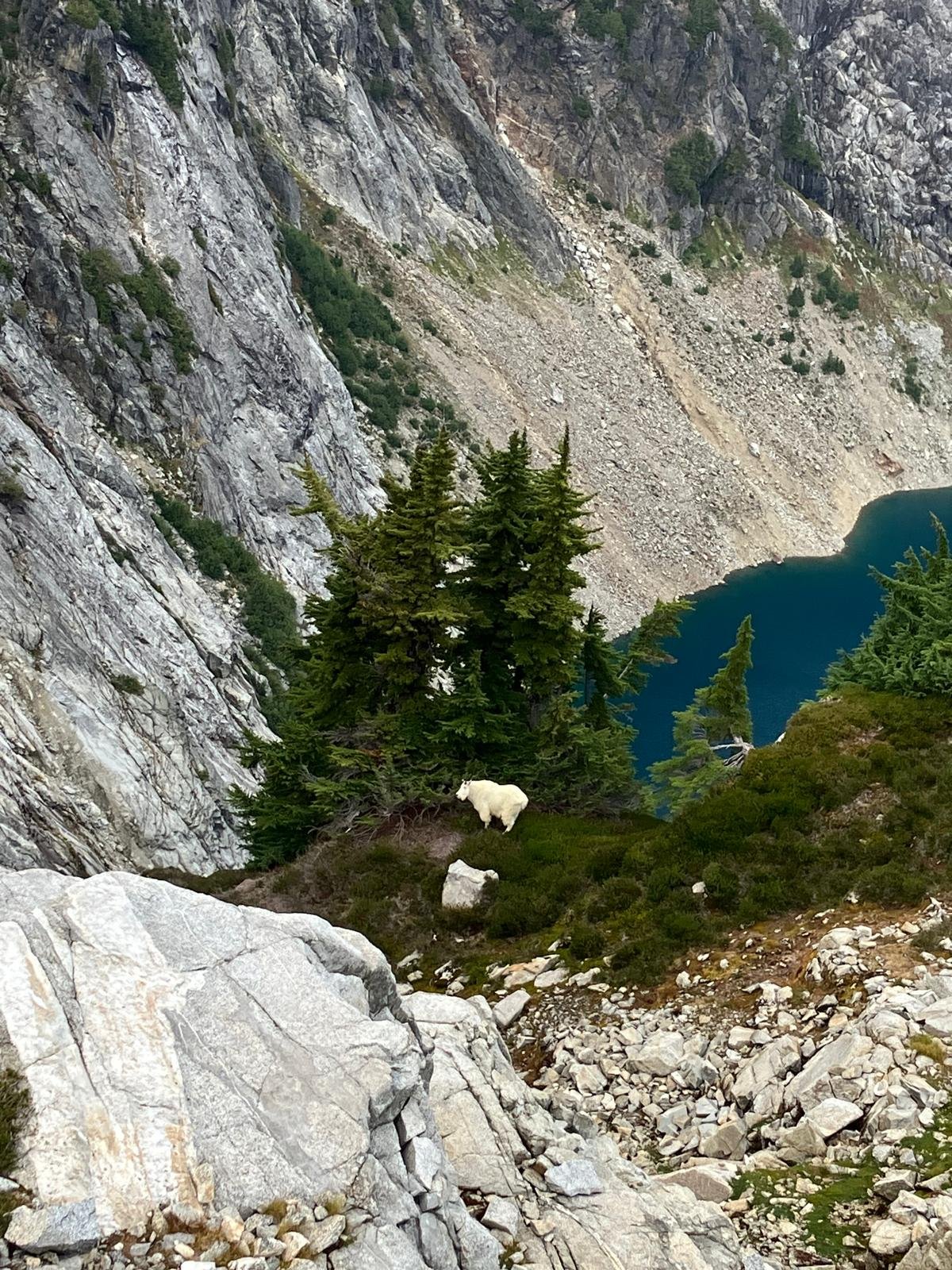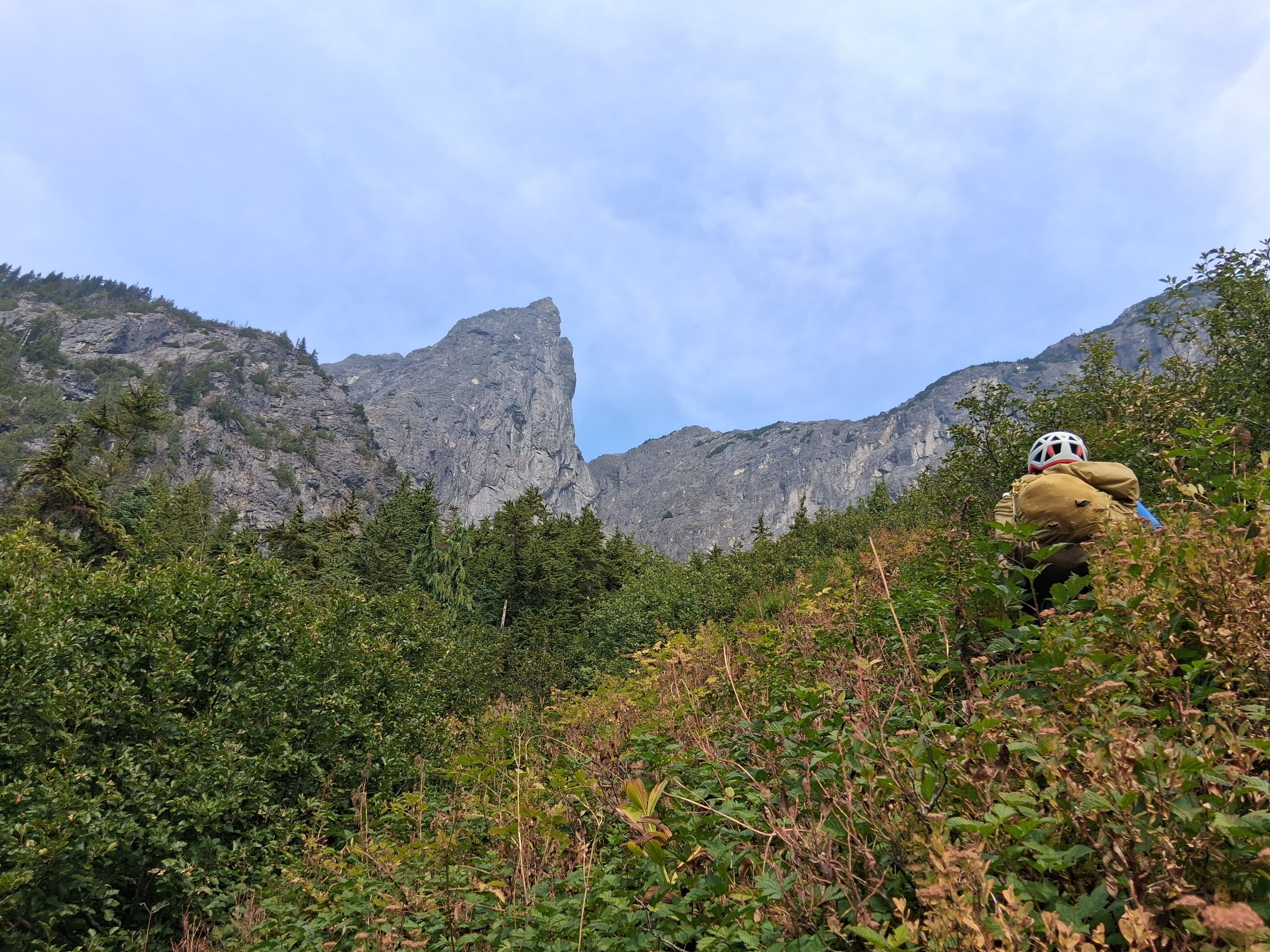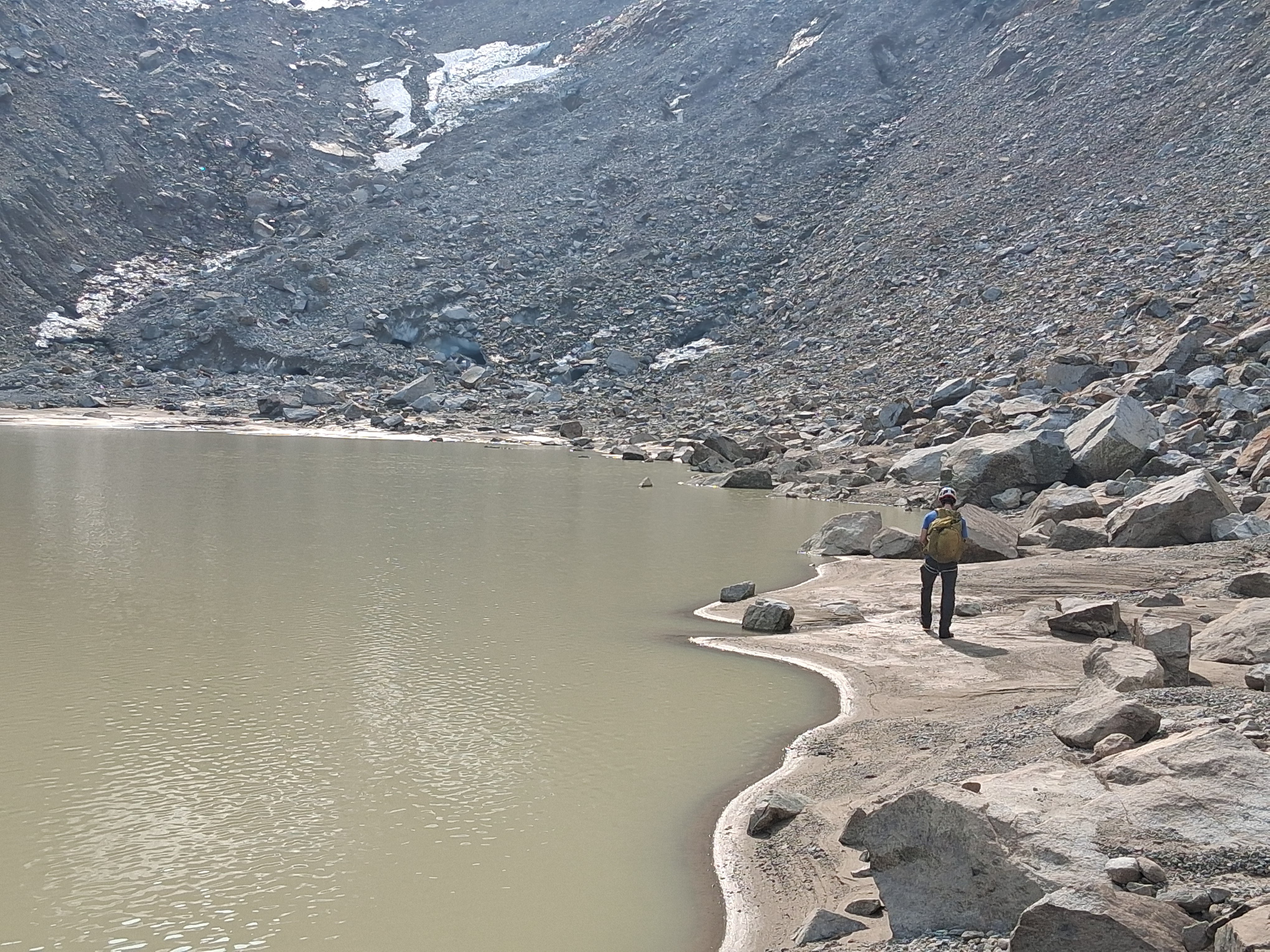Leaderboard
Popular Content
Showing content with the highest reputation on 10/12/25 in all areas
-
Trip: Diptop Peak - South face/rib route - FA - 1,000’, 5.8 Trip Date: 09/27/2025 Trip Report: The complex south (or perhaps SSW) face of Diptop, Jason Hummel photo: “Not too bad for a couple of old guys.” “Not too good either.” The statement and its rejoinder were uttered upon arrival at the truck -- just after dark -- and ended 14 hours of moving, including pioneering a route up (with benefit of hindsight) a questionable objective. Apparently one person’s idea of a good time is another’s idea of a bad time. The exchange echoed an earlier sentiment: “One person’s inspiration is another person's embarrassment”. Diptop is just north of Mt Daniel, and just south of the insta-famous Jade Lake. Rolf sketched our approx route below, fairly borrowed from a Wikipedia image (in turn apparently derived from a pic by Martin Bravenboer): Our "meandering-like-a-drunk" route gained 1,000 vertical feet, and entailed 6 roped pitches (the last one v. short) and a fair bit of soloing. Photos from afar inspired hope that 1. we’d be climbing on granite, and 2. there would be appealing lines on the central buttress of the expansive south face, or on the face itself. Upon closer inspection: 1. the rock was granitic, but one might say it has exfoliated "in an unfriendly manner for free climbing." And 2., while there were cracks and attractive features, it was difficult to ascertain if the seemingly discontinuous lines could be joined. We leave that to more competent and/or bolder parties to figure out. The route was reasonably solid for the alpine, and had its moments of fun. It was mostly scrambling, though it had some contrived steeper climbing and some required steeper climbing. Rolf drew the short final bit -- arguably the crux -- to the ridge crest, not far from the summit. On some of the best rock of the route, although with limited pro, he made a couple of sporty moves with a Vlad-the-Impaler flake threatening his nethers: Despite a "limited alpine skill set", perhaps indeed an “ordinary person accomplishing extraordinary things” is possible, if by extraordinary the speaker meant finding an ignominious way up a fractured granitic face. Maybe they were just “projecting insecurities", since this venture was their pet project. We might have been mildly disappointed with the route, but random insults like “twee”, “cloying”, “piker”, and various vitriolic un-printables kept the mood light. And the surroundings weren’t half bad. A couple more photos below. First roped pitch, after several hundred feet of soloing up to 5th class: Relatively high on the route: An oblique look at the central buttress from the summit area: We approached from the Tonga Ridge/Deception Cr cutoff trailhead. This much shorter approach from the north (vs coming from the south) does require travel up/down some steep timber, duff, and a bit of brush, but offers scenery, solitude (until arrival at Marmot and Jade Lakes), and berries. A little off the optimum route on the last steep stretch of the return, while monkey-bar-jungle-gyming from tree to tree down pine-needle covered duff, someone might have mumbled “we can always rap”. I’m happy to share our approximate track if you’re interested in approaching the scenic lakes without the trail slog. More photos here: https://photos.app.goo.gl/H1e1ExQ1PTVEohUE8 And more about the rock in the area here (courtesy of Rolf: https://bluemarbleearth.wordpress.com/2024/09/16/tuck-lake-and-jade-lake-geology/ Gear Notes: Took a standard double rack, but a single would do. Approach Notes: See above. To access the south face, wander down from Diptop Gap.2 points
-
Trip: Strathcona Provincial Park Ramblings - Big Interior, Septimus, and Kings Peaks Trip Date: 07/21/2025 Trip Report: This past July @Trent and I went on a ramble to Strathcona Provincial Park up on Vancouver Island. We were supposed to meet up with @wbk at the end of the week to give the Colonel Foster Traverse a go, but we wanted to ease into it. And so we did, sort of. Or maybe we just got schooled by the "Island Alpine" we had heard so much about from @wbk. First off we had to navigate the BC ferry options to the island, which tend to book up early. Nevertheless their ferry system makes ours look decidedly second class, and it all worked our pretty smoothly once we were booked and in line. First stop was the trail to Bedwell Lake which I suppose is a good trail by Island standards, but a grunt nontheless. The bugs weren't bad at the lake but increasingly became annoying as we climbed to our camp just below Jim Lake. We were up early the next morning, rambling up and across on the climber's path to Big Interior. It turns out most use this as an approach to Nine Peaks, but we didn't fancy carrying all of our overnight and climbing gear over the summit and so we settled for the "approach" summit of Big Interior. The bugs, heat, and humidity followed us every step of the way. Nine Peaks from Big Interior: @Trent pulling up on to the summit of Big Interior: The views, of course, were grand, and we barely knew any of the peaks in any direction. So much to do in every range it seems like, there is never enough time to climb them all! But we at least had to climb another on this trip, so we reluctantly retraced our steps to camp. And then promptly moved it to Cream lake, to prepare for the aptly named Green Ridge on Septimus. Camp at Cream lake with Septimus looming above: Septimus: Cream lake: We were up early the next morning, crashing around the lake and down, down, down to meet the start of the Green ridge. Do not underestimate this approach! It is every bit a thrash as anything in the Pickets or North Cascades and was especially character building in the heat, bugs, and humidity. Thankfully we were through most of it in a few hours and soon battling the steep rock and veg into the alpine. @Trent out of the brush and about to do battle with steep veg on the Green Ridge: But soon enough we emerged into the full blown Island Alpine and the grand north wall of Septimus and Rosseau was revealed: Looking down at Green lake from Green Ridge: As we scrambled higher, we came across one of the more vivid bits of rock I have encountered in the mountains. Maybe some pillow basalts that have been smoothed by ice? And then a short rap, some steep snow and steeper rock (but still 4th class) as we wheezed our way above the bugs and on to the summit of Septimus: @Trent on the summit of Septimus: There was quite a flower garden directly on the summit of Septimus: And then the 5-6 raps down the South (regular) route on Septimus. We had heard that you may need two ropes to make this work, but it went fine with a single 60m. Take care if anyone is below you though, much loose rock! By the time we got back to camp it was late afternoon, the bugs were fierce, and a swim was called for to think about our options. It was decided that we would spend another night at Cream Lake, hike out for a "rest" day and then try for a single day trip before meeting up with @wbk later in the week for Colonel Foster. I mean, we're going to do all that, right? But first, there was a sunset to enjoy: In the morning the bugs were still fierce, the heat and humidity back in full force as we packed up to hike the Bedwell trail back to the car. Parting view of Septimus: Big Interior and Bedwell Lake: Thanks to a friendly campground host in the park, we found an excellent free place to camp just outside the park and on the way to Gold River. It was about this point that our appetite for Colonel Foster was waning as the pull of home and no bugs was growing stronger: But first, another peak! We had chosen the "hiker's" route up Kings Peak as the day trip the following, knowing that it was a big grunt and was likely to be hot and buggy as well. Still, it was enough of a challenge as to feel like easy mountaineering, and it was hard to beat the views. There are loads of very steep climbs on Kings, maybe the highest concentration of hard routes on any peak in Strathcona Provincial Park. But we didn't climb any of them! We did oogle other nearby mountains like Elkhorn, for a future trip to the Island: And of course, the Colonel: Soon we were on the summit with the ravens on a perfect day, finally above the bugs and the heat, feeling the bliss of "Island Alpine": But it wouldn't last. We were tired from 5 days of rugged Island peak bagging, and a bit mad from the bugs as we descended. We got in the car, changed our ferry reservation and headed home. Sorry @wbk, we'll have to come back for the Colonel! Gear Notes: 60m half rope (Septimus Green Arete), ice axe, helmet, crampons Approach Notes: BC Ferries2 points
-
1 point
-
Right on. After doing forbidden and looking at that face I knew we had to do something on that face. In the late 80's my buddy Ralph and I started off early July with the intention doing the route that said 20 pitches of 5.6. So just brought handful of nuts,tricams and titons. We ended up going to the left of you and left of that gully. Most of the gully's were wet,we had to use the two tools just to get on the rock after that it seemed constant 5.8 with some harder for 10 to 12 pitches of really good rock. Then we started getting into wet and greasy stuff I ended lowering off a couple of pieces and tried going left and right no go. I found a snow covered ledge that barely fit. We cleared it off put our bivy sacs down and then heard something coming from above well we hugged the wall and a nice chunk of ice landed on the ledge. Oh well it was getting dark so we ate some food and talked how we didn't have enough gear to safely rappel and how long we would probably wait for a rescue all while looking down at the road. We brushed and flossed our teeth and went to sleep sorta. In the morning Ralph thought he seen a runner hanging off a horn way to the left above so wth tension and what was left of our meager rack I got to it and got to some dry rock that easy class 4. Whoo hoo we hauled ass to the summit and started the descent a few rappels and we were at the top of CJ gully. That was definitely the closest we got to getting nailed by rocks. One person would look up and yell when the other would run to (shelter) there wasn't much of that. So getting home looking at Fred's green book it seemed we might of done the route that was written up as generally unpleasant and frightening. A couples years later I was walking around north Seattle and met Don Brooks pushing a stroller with two newborn with another kid walking, it seems they just wanted one more but got a extra one. Anyhow he was with the group that did the unpleasant route, he said he didn't write the entry and felt it wasn't bad. I felt the same should of done it later in the summer and don't go down CJ gully in the afternoon. Ralph said his favorite memory is sitting on that ledge flossing his teeth and thinking we were fucked! Always thought that face would be amazing in the winter.1 point
-
Trip: East McMillan Spire - North Buttress Trip Date: 09/24/2025 Trip Report: As Blake seems to speculate in the back of Cascades Rock, this is a legitimately high quality route. While the rock is of course worse than Index or Supercave, it is better than the E ridge of Inspiration or Stoddard Buttress on Terror (and much better than Megalodon). It's also less vegetated than the E face of Triumph or Sloan SW face. There was only one pitch we wouldn't recommend (up high in the schist band), but it can and should be avoided. The steep middle section is characterized by thin parallel cracks, highly textured ripples, and shady climbing with a shocking lack of lichen. When you emerge onto the slightly more West facing schist band for the last few hundred meters, lichen becomes tiresome as the angle eases and rock deteriorates. There are absolutely a couple of serious runouts, but they occur on clean, solid rock. From camp on a small heather patch a few minutes below Little Mac, we approached via a ledge just below Little Mac that accesses the NW trending ridge toward Elephant Butte. We made four rappels beginning at at an old station I had found during a recon trip in October 2020. This seems likely to be the rappel used by the 1986 party, maybe also the 1976 party, and I think @rat has also mentioned climbing the buttress, so perhaps used it as well. The 2008 party (AAJ, NWMJ) approached via Stetattle ridge. After four 45-55m rappels, we walked and scrambled easily to the base of the buttress. We simulclimbed 200-300m on the lower buttress, then belayed eight ~45-50m pitches (5.8 to 5.10-), then simulclimbed (interrupted by one belayed pitch, which we would recommend avoiding) to the summit. For the central, steep section we wanted to climb near but right of the buttress crest, which except for pitch 2 (a horizontal leftward traverse) yielded a logical path almost directly upward. Looking upwards from low on the buttress, two corners right of the crest (separated by a chossy roof) seem to provide the obvious options into the steeper middle section. We aimed for the left corner (which we presumed was the 2008 route), and thought the right corner was probably the 1986 route. We encountered many pieces of fixed gear throughout the route (mostly knifeblades, with a few nuts, a hex, and a rigid stem friend). Since the 2008 party rappelled the face (!!!), presumably close to their line of ascent, we think we followed large portions of their route (Come Over to the Dark Side). That said, I haven't really managed to match the route lines in either the NWMJ or AAJ to our experience (at least at the resolution I can manage to download). From the summit, we downclimbed SW to the col with West McMillan, then continued downclimbing S in the gully for a few minutes. When the gully's left wall flattened, we slung a boulder and made four 45-55m rappels to reach low angle slopes and walked back to camp, arriving about 15 hours after leaving that morning. West McMillan, Inspiration, The Pyramid, Degenhardt, and Terror from high on the route: From left to right: E McMillan, W McMillan, Inspiration, The Pyramid, and Degenhardt. The route goes just right of the sun/shade line on the leftmost peak. The approach rappels start down a relatively solid corner just right of the low point on the left). Photo by Steph Abegg: First rappel into McMillan Creek cirque: Racking up before the first simul block: Marlin starting up the first simul block: Marlin at the top of pitch 1: Partway across the pitch 2 traverse (photo by Marlin). There was a fixed two-pin anchor at the end of this traverse that may be that in the 2008 NWMJ "Erik starts the crux" photo: Looking down partway up pitch 3. This section had some blocks and flakes that looked ominous from below, but sounded and felt solid on closer inspection: The upper part of pitch 3. This was probably the most runout section of the route: Looking down the start of pitch 4: Marlin at the top of pitch 4: Marlin starting up pitch 5: Marlin starting up pitch 6: And navigating the roof on pitch 6: Starting pitch 7: And pitch 8, which should have been the last belayed pitch: Simuling in the schist band: Marlin leading the very-not-recommended lichen covered, loose pitch in the schist band. Go right before here, toward the E Mac col, to keep it scrambly. There was a fixed pin near his feet here, so we weren't the first to get suckered into it: Belaying on the summit. The buttress crest in this section is stacked, lichenous blocks that seem to overhang the impressively steep East face. You want nothing to do with the crest here: Setting up the first rappel out of the E Mac-W Mac gully: Impressive ambience the next morning, looking toward Azure lake from camp: Hiking out, looking toward Triumph: And a friend from the start of the schist band. It was still solidly placed and easily removed after, probably, 17 years (although could use some lube): Gear Notes: Modern gear made a huge difference on this route, especially microcams (compare the 2008 party's rack in the NWMJ pictures), microtrax simuling, and fix-and-following. We took a 50m lead and 65m tag line (we didn't haul), ~5 kbs/lost arrows, at least triples to fingers with offset aluminum and brass nuts, doubles to #1, single #2 and #3, and four microtraxions. Our smallest cams (purple C3 and green/#0 Z4) were used in several critical placements. Approach Notes: Goodell Creek to Terror Basin, then up slabs toward Little Mac.1 point
-
Thanks for the kind words. And yeah, it was way more casual than I expected. I figured there was a decent chance we'd climb through the night. But, nothing went wrong (mostly, we didn't blank out and have to pendulum). Also, while I expected decent rock compared to the Pickets reputation, the rock was vastly better than I'd dared hope. Like, legitimately good. I could list a lot of local granite routes with similar or worse rock. I mean, this is obviously an extremely serious route and environment with some loose, wet, and vegetated rock, and a slight deviation from our path could yield a very different experience. Bailing would be spectacularly unpleasant and expensive. But it's also a much more pleasant and, yeah, casual route than I would have ever expected. And right, re: snow on the approach: the 76/86/08 parties encountered substantial difficulties with glaciers/ice blocks. I also know someone that recently tried to traverse under the McMillan cirque North faces from Stettatle Ridge in late spring, and was turned around by some weird messed up crevasse situation with what seems to be a seasonal glacier (following roughly the Volken ski approach). But, I think they were lower than you'd be to approach the buttress, so maybe it's not a big problem these days. These glacial remnants seem to always be gone by Sept, and we just had one short section under some mildly threatening blocks where we felt the need to scoot (similar to approaching Triumph NE ridge). Here's some more detail: Approach: from the Terror basin bivy, walk/scramble up slabs diagonally toward base of Little Mac. There are bivy sites with year-round water around 6400-6700ft below/S of Little Mac. Find a narrow ledge below Little Mac to access the NE trending ridge toward Elephant Butte. Scramble NE along this ridge for 10-20 minutes, finding a slung boulder about 50m before the first low point/col. Make four 45-55m rappels starting from the boulder, at first in the corner. After the second rappel, walk 20m skiers right on a ledge to find another slung boulder. The fourth rappel finishes over a rotten, red overhang. From the base of the rappels, walk/scramble to the base of the buttress, continuing around to the right/W side, and scramble up and back left toward the crest. In late season (Sept) there will likely be no need to cross snow (although plentiful flowing water), with one area below broken up ice blocks where you’ll want to scoot with some urgency. Early season, though, there may be a seasonal glacier with substantial crevassing that could hinder access (a la Slesse). Route: When the buttress steepens to fifth class, simul climb for 200-300m until a ledge where it steepens further and the pitched climbing begins. Looking up, you will see the buttress crest on your left, then to its right a right-facing corner (2008 route, we think, we climbed this), a rotten looking roof, and further right another weakness/corner (1986 route, I think). Belayed pitches range from perhaps 5.8 to 5.10-, and it’s hard to give per-pitch grades, but p3 is the mental and physical crux. p1 (50m): Begin in the corner directly below the rotten roof (to the right of the upper, left-hand R-facing corner that you're aiming for). When the cracks become wet and filled with moss, traverse a couple of meters right to a cleaner corner, and belay just below the rotten roof. Note: this is what we did, but it may be better to take the next corner left, which aims you straight toward the left end of the chossy looking roof, and thus avoid the traversing pitching. p2 (20-30m): Traverse horizontally left, out from under the chossy roof, passing below another crackless roof/overlap, aiming for the solid/clean rock near the crest. Belay near two rusty pins. p3 (45m): From the old pin anchor, go up and left into the solid corner with clean cracks, passing an ominous looking fridge-sized block that, once you reach it, sounds solid enough to (gingerly) climb on. Continue up placing gear behind surprisingly solid flakes to pass a small roof, emerging on a slab that provides entry to the large R-facing corner at which you've been aiming. Climb the slab up and into the corner on solid rock, but at times little gear, until you can step right onto a pedestal belay. p4 (50m): Climb up from the pedestal toward the left side of the mossy, chossy-looking roof; but traverse right just under the roof on solid, clean face holds, using the roof only at its solid right edge. Emerge onto a large grassy ledge, climb up solid blocks/boulders into a steep, splitter thin hand/finger crack leading to another, larger but sloping grassy ledge. Continue up the grass/heather slightly rightwards to belay at the base of a corner. p5 (45m): Go up and right on the face R of the corner. There are numerous options but they all deposit you on a small sloping ledge where the face converges below the main corner. p6 (50m): Climb up cracks and grooves on the right wall of the corner, aiming for the right side of an overlap below a larger roof. After placing gear in the roof, step left above the overlap and continue up to belay in a small sloping alcove. p7 (50m): Climb rightwards out of the alcove, passing a small roof on its right to emerge onto a rightward-sloping ledge. Walking right will lead to bivy sites; but if not bivying, continue straight up into a steeper, shallow corner with several cruxes (one just off the ledge), belay when you find a good stance. p8 (50m): Climb straight up in a slightly easier corner/groove, stopping to belay when the angle eases. You are now in the schist band: rock quality deteriorates. Simul climb for 50-60m, straight up a broad depression, exiting on steeper, splitter cracks slightly rightwards leading to lower angle slopes facing more westward. We continued simuling, aiming for a steeper ramp 30-50m right of the crest, which had a fixed pin, but was the only bad/scary/chossy pitch of the route. Not recommended. Instead, after exiting the steep cracks, stay low and traverse harder right toward the E Mac-W Mac col, until you reach a broad depression leading straight up (3rd class) to the summit. Descent: Downclimb SW toward the E Mac-W Mac col (2nd-3rd, one 4th move at bottom). Continue downclimbing the dirty gully S for 50-100m, looking for where the left wall of the gully becomes less steep/flat (i.e. creates a small shoulder), where you will find a slung boulder. Make four 45-55m rappels roughly straight down off slung horns/boulders to reach lower-angle slopes. And a route line on a gorgeous picture by @JasonG (happy to pass along higher resolution, just ask): And finally views of the upper and lower buttress, and the rappel corner, from a little past the rappel point:1 point
-
Trip Report: September 27-28, 2025 Climbed this route with my brother, Neta. I rarely write trip reports, but some additional beta for this climb might be useful. Peter's trip report is very accurate, and we followed the yellow lines closely for most of the way. Our description builds off of it, rather than being stand-alone. Beta: There is a climber's path from the lower Thornton Lake to above tree line, and from there it is pleasant travel to the saddle just South of Thornton Peak (48.69136, -121.35286). The traversing descent from there to Triumph Pass matched Peter's description. We found the steep side-slope, followed by a brief slide alder crossing, followed by a steep and cliffy forest to a bit miserable (or should I say, despairing?). This section was one of the cruxes of the route, made worse by the knowledge we have to do it in the harder direction on the way back. However, following the yellow line from Peter's photos worked well. Micro-spikes were very helpful in the side-slopes and in the steep forest. Attached are some GPS points that we recorded to help navigate the steeper portion on the way back. (Note that we did not record the slide alder crossing, which was just SE of the first point, or the steep traverses before that). TriumphBasin.gpx The descent from Triumph Pass towards lake below has deteriorated since August 2021. The glacier receded a lot, and the descent now involves loose scree. As expected from recently glaciated area, the rocks seemed to want to roll downhill at the slightest trigger, and getting through this section would have been challenging in a large group. Being only two of us, we went one at a time in the descent (where we rolled dozens of rocks), and on the way up we stayed very close together (and picked a better route with slightly less rockfall). The traverse from the lake below to the pocket lake below Mount Despair was uneventful (albeit tiring with more side-slopes), and it brought us to our camp as it was getting dark. The next morning we left camp at first light (around 6:30 this time a year) and headed towards the summit. We followed Peter's yellow route to the bottom of the Summit pyramid, to a beautiful saddle (~6600') with a great view. From there, we followed ledges and gullies through steep terrain, dry thorny heather, and loose blocks to reach the summit. On the way up we roughly followed the E ridge with some excursions to the SE Face. Unlike Peter's party we never crossed the ridge to the NE Face, which seemed very intimidating whenever we set eyes on it. The last hundred or so vertical feet below the summit were the most exposed, involving a steep gully and an exposed slab. Overall the climb involved sustained class three terrain where falling would be ill-advised, with a couple class four moves. Not finding a rappel anchor to our liking (did we mention that a lot of the blocks were loose?), we down-climbed the most exposed section, and walked to a saddle South of the summit, taking a better descent path than our ascent route. While the better descent part did not bypass the most exposed section, it meant bypassed some of the 3 gullies via slightly easier terrain, making for a less stressful descent. Below is a rough estimate of our routes, along with photos of Neta on the most exposed slab, and in one of the many gullies. From the bottom of the summit pyramid we retraced our steps, making use of the GPS points we recorded to get through the steep section in Triumph basin. While there may have been a better way then the way we took to get there, we had no desire to waste time route-finding with darkness on our tails. Our only mishap was taking a wrong fork on the climber's path above the middle Thornton lakes that lead us to the outlet of the middle lake, which we did not get to on the way up. It would have made for a nice side trip had we not been so tired. However, as it was, we retraced our steps up to the climber path that we came on (Peter's yellow line). Continuing down the creek to the inlet of the lower lake and connecting to the climber's path from there might have also worked, but we preferred to retrace our steps over an additional adventure. Times: Left the car Saturday slightly after 9am, and reached camp at Lake Despair (is it what it's called? 48.72737, -121.37365) around 7:30pm, as it got dark. On the second day we left camp at 6:40am at first light, summited, and got back to camp at 10:50am. We left camp soon after, and reached the trail at the lower Thornton lake just before 7, happy to avoid off-trail travel in the dark. Back to the car by 9pm. Additional Photos Thornton Lakes, lined up from the saddle: Through the Triumph Creek basin: Mount Triumph, from a flattering angle. To it's right is the scree we had to descend, with the remnant of a glacier. And the loooong way back: Is this as classic as it gets for a North Cascades trip? Bushwhacking with Triumph towering over our head: A goat, with Upper Thornton Lake in the background:1 point


